
Get our Rail Planner app
Plan your trip, get extra discounts, and show your Pass as you go.

Our favourite spring routes
Celebrate spring with these 7 off-the-beaten-path train routes

All about seat reservations
Everything you need to know about booking your seats

Alternatives to Busy Routes
Travel between popular European cities without seat reservations

Through our Chatbot in the bottom right corner.

Ask the Community
Browse questions from fellow Interrail travellers, or ask your own!
- Plan your trip

Interrail railway map
- Order overview
- Reservations overview
- My Trips & Travelers
- {{translatedTraveler}} {{#promotional}} {{currencySign}} {{standardPrice}} {{/promotional}} {{quantity}}x {{currencySign}} {{finalPrice}}
- Child {{childPasses}}x FREE
- {{translatedPassType}}
- {{translatedValidityPeriodDescription}}
- {{translatedClass}}
- Remove Pass(es)
- {{variant.localizedTravelPackDescription}} {{quantity}}x Free
- {{variant.localizedPassUpgradeDescription}} {{quantity}}x {{currency}} {{price}}
- Your order will arrive by {{expectedDeliveryDate}} 1 x {{currency}} {{price}}
Your cart is empty
Start planning your Interrail adventure with our railway map. Wherever you want to go, we'll help you find your way.
Please note that routes may change throughout the year. This map doesn’t show any (temporary) disruptions on the rail network; find more information on rail disruptions here .
Download the map as a PDF →
Austria, Belgium, Bosnia-Herzegovina, Bulgaria, Croatia, Czech Republic, Denmark, Estonia, Finland, France, Germany, Great Britain, Greece, Hungary, Ireland, Italy, Latvia, Lithuania, Luxembourg, Montenegro, Netherlands, North Macedonia, Norway, Poland, Portugal, Romania, Serbia, Slovakia, Slovenia, Spain, Sweden, Switzerland, Turkey.
Train times and reservations
Search for a journey in our timetable.
Ready to plan in a bit more detail? Check train times across Europe in our timetable . See departure and arrival times, service information, and more about seat reservations.
What are seat reservations?
On most trains, you can simply jump aboard with your Pass. But on some high-speed trains and night trains, you'll need to pay extra for a seat reservation . These trains are marked in the timetable.
Not in a hurry? You can usually avoid extra seat reservation costs by taking a slightly slower route.
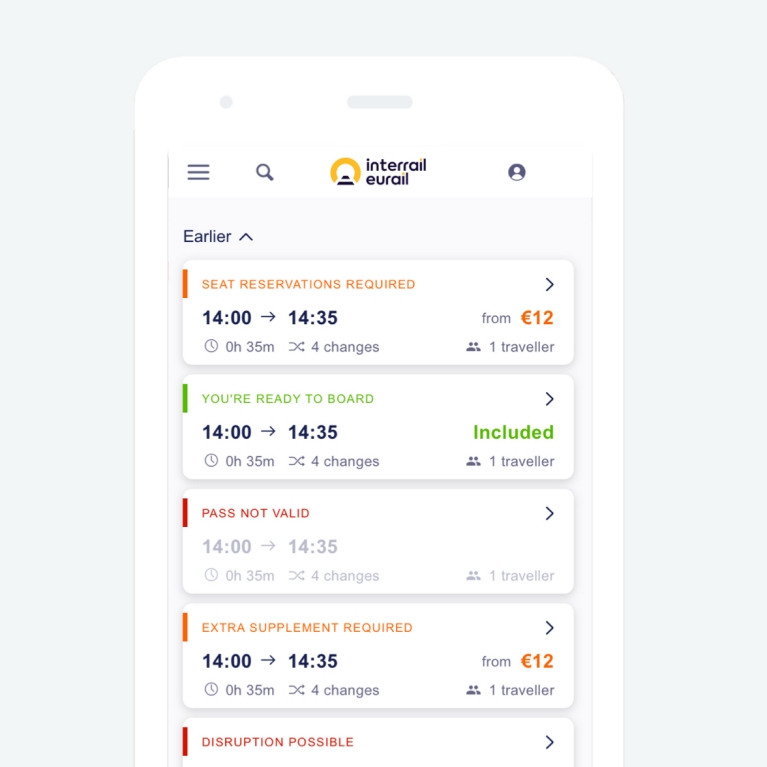
Find the right Interrail Pass
Travel in multiple countries
Interrail Global Pass
Travel to over 30,000 destinations in 33 countries with our classic Pass, delivered straight to your device.
Travel in 1 country
Interrail One Country Pass
Choose one of 29 European countries to explore from top to bottom – you'll feel like a local in no time.
Get inspired

See more recommended routes →
Map your route with our Trip Planner
Travel times for popular routes
See how long it takes to travel by train between some of Europe's most popular cities.
Please note that the seat reservation prices on this page are indicative only and subject to change. Prices may differ when booking reservations through an agent or paying in the local currency.
Change of currency
You cannot change the currency once you have a Pass in your cart. Remove the Pass, and then change the currency on the website header.

The Man in Seat 61
A beginner's guide to
Train travel in europe.
- Buy train tickets
- Buy ferry tickets
- Book a hotel
- Privacy & cookies
- Home
Train travel UK & Ireland...
Train travel in europe..., train travel in asia..., train travel in africa..., train travel in america..., train travel in australasia.
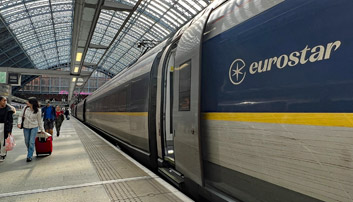
Breakfast in London, dinner in Barcelona
There's no need to fly within Europe. It's surprisingly easy, quick and comfortable to travel by train from London to almost anywhere: Spain, Italy, Switzerland, Greece, Prague, Helsinki, wherever... The difficult bit is finding out how to do it and where to buy tickets. That's where Seat 61 comes in.
This website explains the best routes, train times & fares from London to major destinations all over Europe, and between major European cities.
It explains the best way to buy tickets for your specific journeys, whether you live in the UK, mainland Europe, the USA, Australia, wherever.
Train times & tickets
If your journey starts in the UK , select your destination country in the upper drop-down box to see the best routes, train times, fares & how to buy tickets.
If your journey starts in another European country , select the city where your journey starts in the lower drop-down box - if it isn't listed, select one nearest to it in the same country.
Return to this page for general information & advice about European train travel.
Planning your trip
How to buy tickets, luggage, bikes, dogs & cars, about specific trains & routes, station guides, how to check train times.
If you only remember one European train travel resource
Apart from seat 61 of course - make it int.bahn.de . This has an excellent online timetable for the whole of Europe, probably the most useful European train travel resource on the net. Ask it for Palermo to Helsinki or Lisbon to Moscow and you'll see what I mean. These tips may help:
Place names
It recognises English-language place names & prompts with station or city names.
If you don't know which station to select
The safest option is to select the plain city name, often in capitals, for example PARIS or BERLIN. The system will work out which is the relevant station for your journey.
If it only offers specific stations, try to select the main station in that city, which may be shown as main station or (in Italy) Centrale , in the Netherlands as Centraal , in Germany or Austria as Hauptbahnhof, Hbf or HB (= main station in German), Hlavni in Czech or Glowny (Gl.) in Polish.
In Brussels, Brussels South Station is the main station, also known as Brussels Midi or Brussel Zuid . In Barcelona, select Barcelona Sants . In Verona, select Verona Porta Nuova . In Turin, the main terminus station is Torino Porta Nuova , but the TGV trains to/from Paris use Torino Porta Susa , which many trains leaving from Porta Nuova heading for Venice or Rome also call at. In Venice, Venice Santa Lucia is on the Grand Canal in central Venice, Venice Mestre is on the mainland. In Lisbon, select Lisbon Santa Apolonia .
It only holds data for the main rail operators
Plus some smaller operators, not for all trains everywhere. Notably it does not cover:
- Some private open-access operators such as Italo in Italy.
- The Circumvesuviana Railway, Naples-Herculaneum-Pompeii-Sorrento.
- Euskotren in Spain, operating narrow gauge local trains between Hendaye, San Sebastian & Bilbao.
- FEVE in Spain, who run narrow gauge local trains along the north coastal towns.
- Spanish suburban routes including Barcelona to Latour de Carol and Barcelona to Portbou & Cerbère.
- It doesn't always hold complete or 100% accurate data for the Balkans or Greek domestic trains.
For British train times it's better to use www.nationalrail.co.uk as this will show any engineering work alterations.
Timetable changes in June & December
It usually holds data only until the next Europe-wide timetable change , which happens twice a year at midnight on the 2nd Saturday in June & December. So don't be surprised if it shows no trains running in late December if you ask it in August, that's beyond the December timetable change. Data for dates after the December timetable change usually starts to come online by mid-October and isn't 100% reliable until early December. Also note that data for French, Italian & Spanish trains will only be held for the next few months, not for the whole timetable period.
This system is very good, but some railways (typically the Spanish, Hungarians, Polish & Balkan railways) can be late in supplying data, and data can be unreliable in some parts of the Balkans, for example. If you get strange results you can try the railway operator's own website instead, for example www.renfe.com for Spain or www.ose.gr for Greece. There's a complete list of rail websites on the useful links page .
You can adjust transfer time
By default the system allows the minimum time to change trains, whether changing into a local train that runs every 30 minutes or into a sleeper train which you can't afford to miss. It won't suggest impossible connections, it always allows enough time to walk from one train to the other if the first train is on time, but it doesn't take into account the possibility of the first train running 20 minutes late.
It's a good policy to allow more time for transfers, so click in the From box to open the details panel, then change Transfer time from Normal to (say) at least 40 minutes .
On a through ticket you're legally entitled to later onward travel if a delay means a missed connection ( more info on that here ), but with separate non-refundable train-specific tickets the risk is yours so you should allow more than the minimum, see more about how long to allow for connections here .
You can specify a route or add stopovers
Click Stopovers to set one or two via stations if you want to find journeys via a particular route. By adding a duration in hours and minutes you can specify stopovers at these stations.
Fares & tickets
int.bahn.de will show train times for virtually any journey in Europe, but will only show fares and sell tickets for journeys to, from or within Germany, plus a few cross-Germany routes such as Belgium/Netherlands to Switzerland, Denmark, Sweden, Poland, Czech Republic. To check fares for other journeys, see the How to buy European train tickets page .
DB Navigator is a free online train timetable app for all of Europe, the app version of the German Railways all-Europe online timetable at bahn.de. It provided a journey planner, train details, and calling points, though it needs a WiFi or mobile data connection. To download, go to int.bahn.de/en/booking-information/db-navigator (please let me know if that link stops working).
Railplanner is a free offline train timetable app that you can download onto your phone to check train times & train calling points on the move without the need to be on WiFi or to use mobile data . It's blisteringly quick and covers almost all the train covered by the DB Navigator app. The whole European timetable sits on your phone, with updates automatically downloaded every month. It's created with Eurail and Interrail passholders in mind, but is useful for anyone. Download for iPhone or Android at www.eurail.com/en/plan-your-trip/rail-planner-app - please let me know if the link stops working!
Station arrivals & departures
Click here & enter a station to check scheduled train departures or arrivals at almost any station across Europe. This is an online equivalent of the printed departure posters displayed at stations. It shows real-time information for stations in Germany if you pick today's date, but for 'real time' information in other countries, see the real-time section below .
The European Rail Timetable
The world-famous European Rail Timetable is the train traveller's bible, with route maps and up-to-date timetables for trains, buses and ferries for all European countries, plus trains in Asian Turkey and Russia including the Trans-Siberian railway, ferries to North Africa & the Mediterranean islands.
Published since 1873, it had just celebrated 140 years of publication when Thomas Cook pulled the plug on their entire publishing department, and the August 2013 edition was the last to be published by Thomas Cook. The good news is that the dedicated ex-Thomas Cook team set up a private venture and a reborn European Rail Timetable continues to be published. Remarkably, the timetable has now survived its parent company, as Thomas Cook collapsed in 2019. What does it contain?
Buy online at www.europeanrailtimetable.eu for around £16.99 with shipping worldwide.
If you live in the UK you can also buy from www.amazon.co.uk , it's eligible for Amazon Prime next-day delivery.
Back to top
How to check fares & buy tickets
This section has turned into a bit of an essay . If you just want to know how to buy tickets, skip this section, go to the How to buy tickets page , select a specific journey and I'll tell you how to book it. If you're interested in how European train booking works (or doesn't), read on.
Reality check: No single website sells tickets for all trains in all countries
Although you can look up train times almost anywhere in Europe using int.bahn.de , there isn't a single website that can show fares & sell tickets for every European train in every country.
So you can't go to europeanrailways.com (there's no such site) and buy a Stockholm to Alicante ticket (there's no such ticket). It's perfectly possible to travel by train from Stockholm to Alicante, but we're talking 6 trains run by 5 different operators ticketed with at least 4 separate tickets. Ah, I see from the look on your face that realisation is beginning to dawn...
Each country has its own national operator with its own website
Each national train operator has its own website and its own ticketing system. Then there are various private operators, either genuinely independent such as Italo , Regiojet or Leo Express , or pseudo-independent such as TGV-Lyria created by the relevant national rail operator(s) to run specific international routes.
In fact, Europe has over 50 different rail operator websites selling train tickets for their own trains, even before considering third-party ticket resellers. You need to use the right website for the right journey. So which is the relevant operator for your journey?
If you go to the How to buy tickets page , select your starting city, and on the next page select your destination, you'll find my advice on how to book that specific route.
However, as a rule of thumb, if there's a named operator such as Eurostar or Regiojet you'd go to that operator's website, in this case Eurostar.com or Regiojet.com. If it's a normal international train jointly run by the relevant national rail operators, your starting assumption should be to use the national rail operator website for the country where your journey starts, then check the one where it ends.
The pseudo-independent operators can also be booked at the owning national operator sites
Eurostar is owned by French Railways (SNCF) and others, and Eurostar tickets can also be bought at SNCF's website www.sncf-connect.com . TGV-Lyria is owned by SNCF & SBB (Swiss Railways) and can also be booked at www.sncf-connect.com or www.sbb.ch. The national operator sites can of course book other trains in their respective countries too, in connection with Eurostar or TGV-Lyria. So London to Avignon by Eurostar & onwards French train can be booked as one transaction at French Railways www.sncf-connect.com , for example. It can be useful to know that!
International trains can usually be booked at the national operator website at either end
For international journeys, your starting assumption is to book them at the national rail operator website for the country where the journey starts. But if a train can be e-ticketed, you can also book using the destination country's national train operator website.
For example, Berlin-Prague trains are run jointly by German & Czech national railways, and can be booked at either German Railways int.bahn.de or Czech Railways www.cd.cz with print-your-own tickets.
Now it gets interesting, as this is one of the routes where each partner operator manages advance-purchase price levels independently. So the price at bahn.de might be €39 (with cheaper €19 & €29 tickets sold out), whilst €19 tickets remain available for the same train at cd.cz. It pays to check both!
In fact, even the fixed-price full-flex fare can differ between partner operators. As I write this, Austrian Railways (ÖBB) charge €64 for a full-flex on-the-day ticket from Vienna to Prague, but even if you were in the ÖBB ticket office at Vienna Hbf, it'd be cheaper to whip out your phone and buy exactly the same ticket for the same trains from Czech Railways for €42.
But a word of warning: Check ticket delivery carefully if buying from the operator at the destination end. For example, Austrian Railways oebb.at issues print-your-own tickets for Vienna-Venice trains so can be used for either direction. Trenitalia.com can also book these Vienna-Venice trains, but you must collect a hard-copy ticket from a Trenitalia ticket machine or ticket office in Italy - not much help if you're starting in Vienna!
There are exceptions to this rule, of course. The Paris-Milan Frecciarossas enter France on an open-access commercial basis, so can only be booked at Trenitalia.com, not SNCF-connect.com. Whilst the competing Paris-Milan TGVs enter Italy on an open-access commercial basis and can only be booked at SNCF-connect.com, not Trenitalia.com.
Some trains aren't bookable online at all
Another reality check: Slovenian, Croatian, Bulgarian & Turkish railways don't sell international tickets online, for example. Trains between Slovenia or Croatia & Germany can be booked online in either direction at German Railways int.bahn.de . Trains between Slovenia or Croatia & Austria can be booked online in either direction at Austrian Railways www.oebb.at . But the only way to buy tickets from Ljubljana to Zagreb or Zagreb to Belgrade or Sofia to Istanbul, is at the station.
Longer journeys often need to be broken down into stages
Many international journeys involve a change of train, often this means a change of operator. Operator websites may not be able to sell tickets for such journeys. Nice to Milan can't be booked at the French Railways website www.sncf-connect.com , because SNCF can't access prices or tickets for the Trenitalia train between Ventimiglia & Milan (Ventimiglia is the border station where you change trains). And the Trenitalia website can't book you from Nice to Milan either, because it can't access prices or tickets for the SNCF train between Nice & Ventimiglia. You need to book Nice-Ventimiglia at www.sncf-connect.com and Ventimiglia-Milan at Trenitalia.com . Two tickets, two bookings, on two different websites, such is the reality of Europe's rail network in the 21st century. But there are two specialist retailer sites that resolve this.
Introducing www.raileurope.com & www.thetrainline.com
Two ticket retailer websites deserve a special mention, www.raileurope.com & www.thetrainline.com . These connect to multiple operators, allowing tickets for trains across much of western Europe to be booked in one place.
They have their own journey planning logic, so (for example) they can work out a suitable journey from Nice to Milan using an SNCF train from Nice to Ventimiglia and a Trenitalia train from Ventimiglia to Milan, they then source the Nice-Ventimiglia ticket from SNCF and the Ventimiglia-Milan ticket from Trenitalia, and add them together to provide you with a Nice-Milan journey as one seamless transaction.
I often recommend www.raileurope.com or www.thetrainline.com as they allow you to book tickets together in one place for journeys that would otherwise require multiple bookings on different websites. They are designed for international users, so happily accept overseas payment cards (some national train operator sites struggle) and are written in plain English (some national rail operator sites slip back into local language or use poor English translations). The downside is that they charge a small booking fee, but it's often worth paying that.
Raileurope.com or www.thetrainline.com currently connect to the following national railways: Great Britain (National Rail), France (SNCF), Spain (Renfe), Italy (Trenitalia), Germany (Deutsche Bahn), Austria (ÖBB). They also both connect to private operator Italo . www.thetrainline.com also connects to Swiss Railways (SBB), the Benelux ticketing system (SNCB, NS & CFL) and private operators Regiojet & Westbahn .
Raileurope.com or www.thetrainline.com come as close as you'll get to a pan-European train booking site, but even they don't yet connect to the Portuguese, Czech, Slovakian, Slovenian, Croatian, Hungarian, Danish, Swedish, Norwegian, Finnish, Bulgarian, Turkish, Greek, Romanian, or Polish Railways ticketing systems. So for a €15 Lisbon-Porto ticket you still need to go to Portuguese Railways www.cp.pt and the only place you'll find a €21 Prague-Budapest ticket is Czech Railways www.cd.cz. You get the picture?
More about who Thetrainline are . More about who Raileurope are .
Incidentally, you might also come across Omio.com . Omio has similar connectivity, but at the time I write this it doesn't have any journey planning logic. So although it can sell you a Nice-Ventimiglia ticket using its connection to SNCF if you ask it for Nice to Ventimiglia, and it can sell a Ventimiglia-Milan ticket using its connection to Trenitalia if you ask it for Ventimiglia to Milan, if you ask it for Nice to Milan it will say there are no trains (and will suggest a flight) because it lacks the capability to plan the journey itself and combine multiple tickets. It also says there are no trains for journeys where it lacks the necessary connectivity. For example, Omio says there are no trains from Budapest to Zagreb and suggests a bus, but you can easily buy a train ticket from €19 from Hungarian Railways at www.mavcsoport.hu . So it's important to understand a site's limitations. Omio does have some extra connectivity, for example it connects to Swedish Railways sj.se so can be useful to book Swedish trains if sj.se rejects your credit card, and to Portuguese Railways cp.pt which no other site does.
So which website should you use to buy tickets?
Don't worry! On seat61.com I'll tell you the right website(s) to use for any given European journey (well, almost). Go to the How to buy European tickets page and select your starting city. On the next page, select your destination city. I'll then explain the different ways you can make that specific journey and which website(s) to use to buy tickets.
To check fares & buy tickets in one country
You can check fares & (usually) buy tickets for domestic journeys at each country's national rail website, see the links page for a complete list .
To check fares & buy tickets for international journeys
The national rail websites listed above sometimes sell international tickets to neighbouring countries as well, but often only in a limited way, for example tickets for direct trains. However, you'll find detailed advice on how to book specific international journeys on the How to buy European tickets page . Here are some general rules of thumb.
Rule-of-thumb 1, try www.raileurope.com & www.thetrainline.com .
These connect to the British, French, Spanish, Italian, German, Austrian, Benelux systems and can easily book journeys including multi-operator journeys to, from and within those countries.
Be aware of their limitations: You still need to use other sites for journeys not covered, for example they don't connect to the Portuguese, Norwegian, Finnish, Croatian, Bulgarian, Czech or Hungarian ticketing systems. They also charge a small booking fee, you can avoid paying any fee by buying direct from train operator websites, using the following rules of thumb.
Rule-of-thumb 2 , if you know that the train you want is run by a specific operator, go to that operator's website:
- www.eurostar.com for Eurostar trains between London & Paris, London & Brussels or anywhere in Belgium.
- www.tgv-lyria.com or www.sncf-connect.com for TGV-Lyria high-speed trains between Paris & Switzerland.
- www.regiojet.com for Regiojet trains between Vienna & Prague or Prague & Bratislava.
Rule-of-thumb 3 , otherwise, simply go to the national train website for the country where your journey starts. Although there are many exceptions to this rule, as you can see below:
- For journeys starting in London :
www.eurostar.com for Eurostar to Lille, Paris, Brussels or anywhere in Belgium.
www.nsinternational.nl or www.b-europe.com for journeys to Rotterdam, Amsterdam or anywhere in Belgium or the Netherlands.
www.raileurope.com or www.thetrainline.com for journeys to anywhere in France, Germany, Spain, Switzerland, Milan, Turin, Germany.
- For journeys starting in Paris & France :
The French Railways site www.sncf-connect.com sells many journeys from Paris & French cities to neighbouring countries.
For journeys from Paris to Germany, it's better to use German Railways int.bahn.de .
For journeys from Paris & France to Italy, Spain, Portugal, Austria it's better to use www.raileurope.com or www.thetrainline.com .
- For journeys starting in Brussels, Bruges or Belgium :
The Belgian Railways international site www.b-europe.com will handle journeys to neighbouring countries.
For journeys from Belgium to Germany, Austria, Switzerland, Denmark, Sweden, Czech Rep. it's better to use German Railways int.bahn.de .
For the Nightjet sleeper from Brussels to Vienna it's better to use Austrian Railways www.oebb.at or www.thetrainline.com .
- For journeys starting in Amsterdam & the Netherlands:
The Dutch Railways international site www.nsinternational.nl will handle journeys to neighbouring countries.
For journeys to Germany, Austria, Switzerland, Denmark, Czech Rep., Sweden it's better to use German Railways int.bahn.de .
For the Nightjet sleeper train from Amsterdam to Munich, Innsbruck & Vienna use Austrian Railways www.oebb.at or www.thetrainline.com .
- For journeys starting in Switzerland :
The Swiss Railways site www.sbb.ch can book journeys to neighbouring countries, for example Paris.
For journeys to Paris you can also use French Railways www.sncf-connect.com , it's worth checking prices there too.
For journeys to Italy, it's better to use Italian Railways www.trenitalia.com as SBB can't sell Trenitalia's cheap fares beyond Milan.
For journeys to Germany, Benelux & Denmark it's better to use German Railways int.bahn.de .
For journeys to Austria you'll often find cheaper prices at the Austrian Railways site www.oebb.at .
For the sleeper train from Zurich to Prague sleeper, book using Czech Railways www.cd.cz as Sbb.ch can't sell it.
For the sleeper trains from Zurich to Vienna, Budapest, Hamburg & Berlin use Austrian Railways www.oebb.at or www.thetrainline.com .
- For journeys starting in Italy :
The Italian Railways site www.trenitalia.com can book many international trains from Italy, but not the French-run trains Milan-Turin-Paris.
For journeys from Milan or Turin to Paris, use French Railways www.sncf-connect.com . Add connecting tickets from other cities at www.trenitalia.com .
It's better to use Austrian Railways www.oebb.at for Venice-Vienna day & sleeper trains, Rome-Florence-Vienna/Munich sleeper trains.
- For journeys starting in Germany :
German Railways int.bahn.de sells through tickets to most neighbouring countries.
For travel to Austria, it's often cheaper to use Austrian Railways www.oebb.at , so check this too.
For travel to Prague, it's often cheaper to use Czech Railways www.cd.cz , so check this too.
For Nightjet sleeper trains within Germany & to Switzerland & Austria, it's better to use Austrian Railways www.oebb.at .
- For journeys starting in Austria:
Austrian Railways www.oebb.at can book journeys to most neighbouring countries.
For travel to Germany, also check German Railways int.bahn.de as they can occasionally be cheaper for the same train.
For travel to Prague, check prices at Czech Railways www.cd.cz too as they can be cheaper than ÖBB for the same train.
- For journeys starting in Prague :
Czech Railways www.cd.cz can book journeys to most neighbouring countries.
For journeys between Prague & Brussels, Amsterdam, Copenhagen, Stockholm also try German Railways int.bahn.de .
- For journeys starting in Budapest :
Hungarian Railways www.mavcsoport.hu can book journeys to most neighbouring countries.
For journeys to Germany, you can also check prices at German Railways int.bahn.de , but the Hungarians are usually cheaper.
For journeys to Austria, you can also check prices at Austrian Railways www.oebb.at , but the Hungarians are usually cheaper.
The sleeper trains from Budapest to Zurich & Munich can also be booked at www.oebb.at .
- For journeys starting in Slovenia or Croatia
Zagreb or Ljubljana to Germany can be booked at German Railways int.bahn.de .
Zagreb or Ljubljana to Austria can be booked at Austrian Railways www.oebb.at .
Other international journeys (e.g. to Belgrade or Budapest) cannot be booked online, you have to go to the station.
- For journeys starting in Poland :
Polish Railways haven't yet enabled online booking for international trains, except for than Berlin-Warsaw.
You can book from Warsaw or Krakow to German cities at German Railways int.bahn.de and print out your ticket.
The sleeper train from Warsaw & Krakow to Vienna can be booked at Austrian Railways www.oebb.at as you can print your own ticket.
All other international tickets starting in Poland can be arranged through reliable ticketing agency www.polrail.com .
- For journeys starting in Copenhagen :
Danish Railways www.dsb.dk can't sell international tickets.
German Railways int.bahn.de can sell tickets from Copenhagen to Germany, Brussels, Amsterdam, Prague, Switzerland.
- For journeys starting in Stockholm & Sweden :
Omio.com (formerly GoEuro) or www.sj.se can sell tickets to Oslo or Copenhagen or within Sweden.
German Railways int.bahn.de can sell tickets from Stockholm, Gothenburg & Malmo to anywhere in Germany.
German Railways int.bahn.de can also sell tickets from Stockholm, Gothenburg & Malmo to Amsterdam, Brussels, Switzerland & Prague.
Rule-of-thumb 4 , break the journey down
I have lost count of the times I've advised travellers to split the booking and book each section of the journey, or if necessary, each individual train, at the relevant operator's website.
For example, int.bahn.de comes up with silly-money €246 prices if you ask it for Paris to Vienna, a journey which passes through Frankfurt, but it will happily sell you a Paris-Frankfurt ticket from €39 and a Frankfurt to Vienna ticket from €29 if you break the journey down.
Similarly, Prague to Venice can't be booked online anywhere, but the Czech Railways site www.cd.cz/eshop will happily sell you a Prague to Vienna ticket from €14 and Austrian Railways www.oebb.at will book the Vienna-Venice sleeper from €59 with couchette.
There are endless examples of this all over Europe, some creative thinking is often required!
Rule-of-thumb 5 , some trains cannot be booked online
Remember that some trains simply cannot be booked online so will need to be booked by phone or at the station. For example Zagreb to Belgrade, Belgrade to Montenegro, or Sofia to Istanbul.
I'll say it again, for advice on which website to use for which specific European train journey, see the How to buy European train tickets page .
It matters whom you call! Some agencies are better for some journeys than others because of the ticketing systems they use.
You'll find a list of agencies with advice on who to call on the How to buy train tickets by phone page .
Maps of the European rail network
Free online rail maps.
This free online rail map of Europe is a good basic overview of the extent of the European railway network. It's intended for people using a Eurail or Interrail pass so leaves out many routes in non-Interrail/Eurail countries such as Russia & Ukraine, and leaves out many smaller lines even in countries covered by these passes.
For more detail, try the zoom-able online map of European (and indeed, world) railways at www.openrailwaymap.org .
You can also try the Swiss Railways all-Europe online map at maps.trafimage.ch . Zoom in for more detail.
For the best (and official) map of the UK rail system, click here .
For an online map of the French rail network click here .
For an online interactive map of the German rail network click here .
For the best (and official) map of the Swiss rail system, click here .
But for a decent map of all European train routes, you really need to buy one of the printed rail maps listed below.
Rail Map Europe: Buy here
Travellers' railway map: buy here, rail atlas of europe by ian allan: buy here.
Ian Allan Publishing do an excellent hardback rail atlas of Europe for around £21, available through Amazon.co.uk . You can also buy it in the USA at Amazon.com .
Rail Atlas of Europe by M Ball: Buy here
There's another highly-detailed European Railway atlas covering the whole of Europe, europeanrailwayatlas.com , price £24.95 in 122-page paperback book form covering 23,000 locations with free PDF version for your computer, tablet or phone.
Real-time train running information
Are the trains running on time? Delays, incidents, strikes or disruptions?
London to Paris or Brussels by Eurostar
Changing trains in paris.
Train journeys from the UK into Europe often involve a change of train and station in Paris. Eurostar arrives at the Gare du Nord , which is an easy 7 minute 500m walk from the Gare de l'Est but a metro or taxi ride from the other Paris stations including the Gare de Lyon .
See the Changing trains & stations in Paris page for advice on metro, RER and taxi travel, and an easy route guide.
The Paris metro website is www.ratp.fr .
If you want to spend some time in Paris, by all means take an earlier Eurostar on the outward journey or a later one on your return. There are left luggage lockers at several Paris rail stations if you need to leave your luggage somewhere.
You can avoid the hassle of crossing Paris when travelling to many French destinations, by changing at Lille , see the London to France page .
Changing trains in Brussels
The ferry alternatives, london to paris by train & ferry.
London to Paris 'sleeper' option via Portsmouth-Caen: There's an overnight train-ferry-train option where you can leave London Waterloo around 18:30, sleep in a comfortable cabin with en suite shower & toilet 22:45-06:45 on Brittany Ferries' overnight sailing from Portsmouth to Caen, then take a train from Caen to Paris St Lazare arriving around 11:05. This is not a bad option if you need an alternative to Eurostar. Times, fares & info for travelling from London & Portsmouth to Paris by overnight train & ferry are shown here .
London to Amsterdam by train & ferry
Uk to spain by ferry, other useful ferry routes.
DFDS Seaways ( www.dfds.com ) sail overnight from Newcastle to IJmuiden near Amsterdam, see the Newcastle-Amsterdam page .
Should you go 1st or 2nd class?
2nd class is absolutely fine for most travellers. There's no need to pay for a 1st class ticket to travel in comfort these days, especially on the fast modern air-conditioned express trains. So if you're on a budget, don't bother with 1st class unless you are offered prices that make it silly not to upgrade.
For most of us, 2nd class is the norm unless the Company is paying. If you're visiting Europe from overseas, rest assured that there are very few peasants and chickens in 2nd class these days.
What more do you get in 1st class?
First class gets you wider seats, plusher seats, more leg and elbow room, and fewer passengers per coach. In most cases, assume that is all. Luggage room is the same, perhaps with fewer passengers per coach using it, but this is not a sensible reason for paying a 1st class fare as there's always room for luggage in any class.
On a few premier trains including Eurostar , Spanish AVE trains & Lyria , some 1st class fares include an at-seat service of food & drink, but these are the exceptions. Unless you're told otherwise, you should assume that a 1st class ticket simply gets you a nicer seat with more leg and elbow room, surrounded by more business travellers with laptops and fewer families with kids. On German ICEs and Austrian railjets , food & drink is not included but in 1st class a steward will take orders and serve you at your seat, in 2nd class you have to go to the bistro or restaurant car.
Tables for two & solo seats: First class cars generally have seats arranged 2+1 across the width of the car (two seats abreast, then the aisle, then one solo seat), hence the wider seats with more elbow room compared to 2+2 seating in 2nd class. So in a typical first class car you'll find face-to-face tables for two and solo seats as well as tables for four - if you're a couple, facing each other across an intimate table for two, both of you getting a seat that's both window and aisle, is a key advantage of going 1st class. As is booking a solo seat if you're travelling alone, a seat that's both aisle and window, where you aren't sitting next to anyone else.
Train seat numbering plans : Click here for train seating plans
1st class can be an affordable treat
Don't decide until you see the price! Most train operators have airline-style variable pricing, you might find 2nd class costs €40 and 1st class only €45 because of the way the price quotas have worked in each class. In which case you'd be crazy not to pay an extra €5 to upgrade!
On sleeper trains, class is irrelevant
On sleeper trains, whether you have a 1st or 2nd class ticket is almost irrelevant, as your comfort depends on the type of sleeping accommodation you pay for: Seat, couchette, or sleeper. A 2nd class couchette is more comfortable (and more secure) than a 1st class seat. A 2nd class sleeper is more comfortable than a 1st class couchette (where such things exist). In fact, on most routes only a 2nd class ticket is now needed for a 2-bed sleeper. On nightjet sleeper trains , for example, all accommodation is now classified as 2nd class, even deluxe sleepers with shower. The options for travelling on overnight trains are explained here .
Should you make a seat reservation ?
Local, suburban & regional trains in most countries don't have seat reservations. You just get on and sit where you like, like the London Underground or New York Subway.
Long-distance trains in France, Italy, Spain, Portugal, Sweden & Poland are usually all-reserved and every ticket comes with a seat reservation automatically included, free of charge. The same goes for international trains to, from or between these countries including Eurostar , TGV-Lyria , Paris-Barcelona TGVs , Paris-Milan TGVs , Paris-Milan Frecciarossas and Paris-Germany TGV/ICE trains . Such trains often don't have any displays showing which seats are reserved and which free because it's assumed that all passengers have a reserved seat.
Long-distance trains in Germany, Austria, Switzerland, Denmark & much of central Europe are usually reservation optional . You can travel without a reservation (the risk is you may have to stand at busy times) or you can pay a small fee to reserve a seat. If you don't have a reservation you can sit in any empty unreserved seat - an electronic display above each seat (or on older trains, a little printed slip in a slot) show which seats are reserved.
Making a short journey mid-week in February as a solo traveller I might not bother making a reservation, especially if I'm joining at the station where the train starts so will have my pick of the seats. But if you're making a long journey or travelling on a busy Friday or Sunday afternoon or travelling with your family or in a small group, I strongly recommend making a reservation to be sure of a seat. You are usually offered the option of adding a seat reservation when buying a ticket online, if you fail to add one you can sometimes make a separate seat reservation only booking later, the German, Austrian & Czech railway websites can do that, but not all websites.
Forward-facing seats
I know from experience that American visitors in particular (if you'll forgive me for saying so) are obsessed with facing forwards. Europeans less so, as we are used to trains with half the seats facing one way, half the other, and we know that it's no big deal as trains run smoothly on rails - think cruise liner restaurant, where half the diners are going backwards at 18 knots without noticing!
On most European trains you cannot specify which way your seat faces. The reservation system knows the carriage seat layout, but it cannot predict which way round the train will enter service that day. Indeed, on some routes the train reverses en route, for example on a journey from Rome to Venice, seats which are backward-facing from Rome to Florence will be forward-facing from Florence to Venice as the train changes direction at Florence SMN which is a terminus. Similarly, trains from Zurich to Innsbruck, Salzburg & Vienna change direction at Buchs, before the Austrian border.
There are a few cases where a forward-facing seat can be requested. Some operators including Eurostar keep their trains a particular way round, for example on Eurostar car 1 is always at the London end, car 16 at the Paris end. You can often select your seat from a seat map when you book such trains direct with the relevant operator, the direction of travel is often indicated on the plan so you can see which seats face which way. On a few TGV routes in France a clever dual numbering system allows the correct set of numbers to illuminate depending which way round the train is, which in turn allows the reservation system to offer a choice of forward-facing seat if you book at www.sncf-connect.com or www.thetrainline.com . In the UK, we have traditionally had a much simpler low-tech system. Two seats facing each other have the same number, say 15, the one facing is 15F and the one going backwards is 15B.
Remember that on trains where reservation is optional (domestic trains in Benelux countries, Germany, Austria, Switzerland, Denmark, and much of Eastern Europe) you can sit where you like, and if you find your reserved seats not to your liking just sit elsewhere. However, in France, Italy, Spain, Portugal, Sweden, all long-distance trains are all-reserved so you usually have to stick with your reserved seats.
My favourite arrangement in first class on most European trains is a face-to-face table for two. Both of you get a window seat, and both an aisle seat, and one seat is always facing forwards. My wife usually gets that! It also means you get the full length of a window to look out of, not half a window.
Which side of the train?
On some routes the best scenery is on a particular side of the train, for example the left hand side going south along the Rhine Valley from Cologne to Mainz, or the right hand side from Switzerland into Austria through the Arlberg Pass. I try and mention which side to sit on the relevant pages of this site, if it matters.
However, many reservation systems won't let you choose which side of the train to sit as the train or carriage could enter service either way round. Only in some cases is direction of travel shown. On trains where reservation is optional (domestic trains in Benelux countries, Germany, Austria, Switzerland, Denmark, much of central Europe) you can sit where you like so can move if your reserved seat is on the 'wrong' side.
First class lounges at stations
There are first class lounges at some major stations, usually with complimentary tea, coffee, soft drinks or even beer and wine, plus WiFi and charging points. Sometimes the lounge is for anyone with a first class ticket (which may or may not include first class Eurail or Interrail passes), in other cases the lounges are only for holders of the most expensive premium-fare first class tickets or who have that train operator's frequent traveller loyalty card. Here's a quick guide:
Eurostar business lounges at London St Pancras, Paris Nord & Brussels Midi
Eurostar has a business lounge opening off the departures hall after security at London St Pancras , Paris Nord & Brussels Midi with complimentary tea, coffee, soft drinks, wine & spirits, beer and snacks. The lounge has toilets, free WiFi and charging points. The London and Paris lounges also have a free cocktail bar, open afternoon until evening.
The business lounges are open to holders of Business Premier tickets or holders of Eurostar's top-tier Carte Blanche loyalty card. They are not open to holders of Standard Premier tickets or railpass holders.
Paris & France
Anyone with any 1st class ticket for TGV-Lyria trains from Paris to Switzerland can use the SNCF Salon Grand Voyageur at Paris Gare de Lyon in Hall 3 with free WiFi, hot drinks and water.
Apart from this, the Salon Grand Voyageur is only open to travellers with SNCF loyalty cards or the most expensive full-price 1st class Pro tickets. You can use it with any 1st class ticket if you have a Eurostar Carte Blanche loyalty card.
All the other major Paris termini and many big city stations across France have an SNCF Grand Voyageur lounge with free WiFi, hot drinks and water, but these are only for passengers with SNCF loyalty cards or the most expensive full-price 1st class Pro tickets. You can use them with any 1st class ticket if you have a Eurostar Carte Blanche loyalty card.
Brussels & Belgium
Eurostar (formerly Thalys) has its own lounge at Brussels Midi, only for Eurostar (formerly Thalys) passengers who have the most expensive Premium class tickets. Not open to holders of Comfort class (= regular 1st class) tickets or to railpass holders.
Apart from this there is no first class lounge at Brussels Midi , but I consider the bar at the Pullman Hotel to be the best VIP waiting room for the price of a beer.
Amsterdam & the Netherlands
There is an NS International Lounge at Amsterdam Centraal at the western end of platform 2 and there are similar lounges at Schiphol & Rotterdam Centraal . You can use these lounges with any type of 1st class international ticket including 1st class Eurail & Interrail passes.
Follow the signs for NS International Lounge, check www.nsinternational.nl for opening times. Tea, coffee, soft drinks and snacks available.
Switzerland
Unfortunately, SBB closed their first class lounges at Zurich & Geneva at the end of 2016, citing lack of use.
Trenitalia has Freccialounges at major city stations. These are only for holders of the most expensive Executive class tickets or who have Trenitalia's own frequent-traveller loyalty card.
Competitor Italo also has lounges at major city stations, branded Club Italo. These are only for holders of the most expensive Club class tickets or who have Italo's own frequent-traveller loyalty card.
There is a Renfe Sala Club lounge at Madrid Atocha , Madrid Chamartin , Barcelona Sants , Malaga Maria Zambrano, Seville Santa Justa, Cordoba, Valencia, Alicante, Girona, Zaragoza Delicias, Valladolid and several other stations.
The Sala Club is open to anyone who has paid the Premium fare, or who has a 1st class ticket for an international AVE (but not TGV ) to France. Typically open from 06:00 to 22:00 every day. You can use them from 2 hours before your train leaves until departure.
Tea, coffee, soft drinks, beer and snacks available. For details search www.renfe.com .
There are DB Lounges at major stations, but only for holders of the most expensive DB Flexpreis tickets. You cannot use the lounges if you have a 1st class Sparpreis or Super Sparpreis ticket or Eurail or Interrail pass.
They don't admit holders of tickets for regional trains or trains operated without DB involvement such as Eurostar (formerly Thalys) , Nightjet , European Sleeper or the Munich-Prague trains .
However, if you have a Eurostar Carte Blanche loyalty card you can use a DB Lounge with any ticket.
There are lounges at Berlin Hbf , Bremen, Dresden, Düsseldorf, Frankfurt am Main Hbf , Frankfurt Flughafen , Hamburg Hbf , Hanover, Cologne Hbf , Leipzig, Mannheim, Munich Hbf , Nuremberg, Stuttgart. Typically open 07:00-21:00 daily, follow signs for DB Lounge , search int.bahn.de for opening times.
There are ÖBB Lounges at Vienna Hauptbahnhof , Vienna Meidling , Linz, Salzburg , Innsbruck , Graz & Klagenfurt.
These Austrian lounges are really useful because you can use them for up to 90 minutes before or after your journey with almost any type of 1st class ticket or with a ticket for any type of sleeper for Nightjet or EuroNight trains and with a 1st class Eurail or Interrail pass.
There's one exception: You can use the lounge with a 1st class DB Sparpreis or Flexpreis fare, but not with a Super Sparpreis fare.
Typically open 06:00-21:00, for details see www.oebb.at & search for ÖBB Lounge . Tea, coffee, soft drinks, snacks & free WiFi available.
Budapest & Hungary
Budapest Keleti has an excellent business lounge on platform 9 , open 06:00-21:30 daily. This lounge is really useful as it can be used by anyone with a 1st class international ticket to, from or via Budapest, or a single or double sleeper ticket, or a 1st class Eurail or Interrail pass with a reservation for a train that day. Unfortunately, there's no lounge at Budapest Deli or Budapest Nyugati.
Prague & the Czech Republic
CD (Czech Railways) has a lounge at Prague Hlavni with newspaper and free WiFi, but it's also open to 2nd class passengers with tickets for the higher categories of train such as EuroCity and SuperCity so it's more upmarket waiting room than 1st class lounge. The excellent Fantova Kavárna upstairs in the historic station hall makes a better VIP waiting lounge for the price of a cup of coffee.
PKP Intercity used to have poorly-advertised lounges at Warsaw Centralna & Krakow Glowny , but strangely closed them in 2014 due to lack of users.
Copenhagen & Denmark
DSB Danish Railways have DSB1 lounges for first class passengers at Copenhagen , Aarhus and Odense. Open Monday-Friday only. Passengers with 1st class tickets for SJ trains to Stockholm or Intercity trains to Germany can also use it. For details search www.dsb.dk and use Google Translate.
Stockholm & Sweden
SJ have a first class lounge at both Stockholm Central & Gothenburg Central open to all first class ticket holders It's open Monday-Friday only morning until mid-evening, for details see www.sj.se .
Travelling overnight
Sleeper trains are a time-effective and romantic way to travel. Huge distances can be covered while you sleep, using less daytime time than flying and often saving a hotel bill, too.
Forget about first and second class on sleeper trains, these terms become misleading. The real classes on an overnight train are seat, couchette and sleeper. In fact, all accommodation on nightjet sleeper trains is now technically 2nd class, even a deluxe single-bed sleeper with shower. Although some operators still require a 1st class ticket for a single-bed sleeper.
Incidentally, trains don't have sterns or bows or port or starboard as they are not a ship. They also don't have cabins , the correct term has always been a sleeper or couchette compartment .
Click for sleeper & couchette car berth numbering plans , this answers the typical worry We have berths 21 & 25, are we in the same 2-berth compartment? Yes, you are!
...in a sleeping-car
A sleeping-car is the equivalent of a hotel : A cosy bedroom, with comfortable beds, washbasin, and room service. Sleepers come in 1, 2 & 3 berth varieties, depending on the route, whether you have a 1st or 2nd class ticket, and the price you want to pay. For the daytime parts of a journey, the beds fold away to reveal a sofa.
If you are travelling alone and don't want to pay for a 1st class single room, you can normally book just one berth in a 2 or 3-berth room and share with other passengers of the same gender (though this is currently not possible in Italian domestic sleepers).
In addition to the normal lock, sleeper compartments have a security lock which cannot be opened from outside even with a staff key, so you'll be both safe and snug. The most modern sleepers now have CCTV in the corridor, too.
On most sleeper train routes there are inclusive fares covering travel, sleeper & breakfast. If you have an Interrail or Eurail pass, you can look up the additional cost of a sleeper on the Interrail & Eurail reservations page .
For more detailed information about what to expect when travelling by sleeper, see the Travelling by Sleeping-car or Couchette page or the information about specific sleeper trains, including:
- Nightjet sleeper trains linking Germany, Austria, Italy, Switzerland.
- Prague to Krakow sleeper train .
...in a couchette
A couchette is rail's answer to a youth hostel or pensione: Economical and comfortable, it's an ordinary seating compartment for 4 or 6 people by day, with fold-out padded bunks for 4 or 6 people by night, each with sheet, rug & pillow which you arrange yourself. Male and female passengers normally share the same compartment (although there are 'ladies only' compartments on most routes), and apart from removing shoes & jackets, passengers do not normally undress.
A berth in a 6-berth couchette compartment costs around €20-€27 per berth per night, in addition to a 2nd class ticket or railpass. A berth in a less-crowded 4-berth couchette compartment costs around €30-€37 per berth per night, in addition to a 2nd class ticket or railpass.
In addition to the normal lock, couchette compartments have a security lock or chain which cannot be opened from outside, even with a staff key, so you'll be quite safe. 1st class couchettes (4 berths per compartment) are rare, they pretty much only exist in on the few remaining French domestic overnight trains .
There's more detailed information about what to expect when travelling by couchette on the Travelling by Couchette or Sleeping-car page . For more specific information, if your journey involves a nightjet, see the nightjet sleeper train page . If your journey involves a French domestic Intercité de Nuit overnight train, see the Intercités de Nuit page .
...in a seat
Although it's the cheapest option, travelling overnight in an ordinary seat is a false economy. It's not recommended however tight your budget, either for comfort or security, unless there's no other option. There's no lock on the compartment door, and no staff on duty. Think of it as the equivalent (almost!) of sleeping in a shop doorway. Always budget for at least the couchette supplement for a comfortable night's journey.
How early to be at the station?
There are some exceptions . Major Italian stations now have a simple manual ticket check between concourse and platform circulating area. In France some major stations have automatic ticket gates when boarding long-distance trains, scan the barcode on your ticket and they open, they're work until 2 minutes before departure. But it's still nothing like air travel.
Train composition posters
Is there passport control before boarding, how long to allow for connections , it takes just minutes to change trains, if your onward train is a local one, if your onward train is all-reserved, if your onward train is a sleeper, if connecting out of a sleeper.
Example You're catching the Cologne-Munich sleeper train, due to arrive in Munich at 07:10. There are onward connections to Salzburg at 07:25 and 09:30, both with cheap fares available which are only valid on whichever specific train you choose. Online systems and the European Rail Timetable suggest the 07:25. But is this a safe connection? No, it isn't. Even this excellent sleeper train can arrive 20, 40 or 60 minutes late, and it pays to be on the safe side. In this case I'd recommend booking the 09:30 and having a leisurely breakfast in Munich.
Through ticket or separate tickets?
Recommended connection times when changing stations in paris, travel tips, what happens if you miss a connection, if things go wrong ..., here's what you should know.
With a through ticket the international conditions of carriage (CIV) give you a cast-iron legal entitlement to travel on by later trains if a delay means a missed connection, so tight connections aren't necessarily a problem.
However, through tickets no longer exist for many journeys and you'll often be given separate tickets for each train. Unfortunately, CIV protection only applies to connections within each ticket, not between tickets.
The good news is that rail staff will usually help you out if there's a delay, as connections between separate tickets and different operators are often covered by the Agreement for Journey Continuation (AJC) or RailTeam/HOTNAT , which I explain below.
If you miss a connection
If you are on a delayed Eurostar and you realise you're going to miss your onward connection, Eurostar train managers carry a HOTNAT / CIV stamp and will endorse your ticket. They may walk through the train helping people with connections, or may announce that they are available in a particular car. Similarly, staff on other European trains can usually endorse or stamp your ticket if their train is delayed.
Tip: If crossing Paris by metro, buy a metro ticket in the Eurostar cafe-bar car to save vital minutes, you might still make your connection.
It's good to be aware of your rights under the international conditions of carriage or CIV and its limitations, and of AJC & HOTNAT .
An example... I was travelling from London to Bordeaux on a Eurostar running 40 minutes late. It looked like I would miss my connection in Paris, and naturally my onward ticket was train-specific & non-changeable! An announcement was made that the train manager was in the bar car to help passengers with connections. He stamped my ticket and told me to go to the ticket office at Paris Montparnasse to get myself rebooked on a later train. In the event, I bought a metro ticket from the Eurostar cafe-bar to save time at the metro station (important tip!), I walked to the front of the train as we approached Paris, I had allowed a little more than the recommended minimum 60 minutes to cross Paris in any case, and I made my connection!
If you miss a Eurostar due to a delayed train
If you miss a connection in brussels, your rights: civ conditions of carriage.
Unfortunately, this CIV missed connection protection only applies within a single contract for carriage, in other words, within one ticket.
If you have a through ticket from A to C changing at B, your connection at B is protected if there's a delay.
But if you have a ticket from A to B and a separate ticket from B to C, your connection at B is not protected by the CIV as this is two separate contracts for carriage and CIV does not apply between contracts. These days, many journeys have to be made using separate tickets.
For example, there are no through tickets between London and Germany, so if you book a journey from London to Berlin, even as one transaction on one website, you'll get a London-Brussels Eurostar ticket and a separate Brussels-Berlin DB (German Railways) ticket. This is two separate contracts for carriage and CIV does not protect you for a missed connection in Brussels, between the two tickets.
The CIV were written when through tickets were the norm for almost all European journeys, these days many through journeys have to be made using multiple tickets. Frankly, the CIV are no longer fit for purpose. I have spoken at the EU Parliament in Brussels on the subject!
Railteam & HOTNAT
Agreement on journey continuation ( ajc ).
The signatories to the AJC are:
SNCF (French Railways), DB (German Railways), ÖBB (Austrian Railways), Trenitalia (Italian Railways), Renfe (Spanish Railways), SBB (Swiss Federal Railways), BLS (Bern-Lötschberg-Simplon Railway), CD (Czech Railways), SNCB (Belgian Railways), NS (Dutch Railways), CFL (Luxembourg Railways), DSB (Danish Railways), SJ (Swedish Railways), SZ (Slovenian Railways), ZSSK (Slovakian Railways).
Eurostar signed up to the AJC in 2023, as did MAV (Hungarian Railways), PKP (Polish Railways), HZPP (Croatian Railways) & European Sleeper .
The AJC doesn't currently cover some open-access operators such as Italo, Westbahn, Regiojet, Leo Express.
To qualify for help under the AJC:
Both trains have to be run by signatories to the agreement.
You have to be making an international journey, not a domestic one.
You must have allowed reasonable period of time between trains, meaning at least the minimum applied by official journey planners.
You may need to get proof of the delay from the delayed operator, which they are obliged to give you.
Onward travel has to be on the same operator on the same route. It is either the station staff or the train manager for the onward train you gives you permission, you should ask at the interchange station.
Remember that the AJC is a commercial agreement between operators, it's not a passenger right you can claim. So politely remind staff about it if they don't seem to know about it.
A traveller's report
A traveller reports: "I got to my local station and there were no trains going anywhere! There had been an emergency that stopped all trains for half an hour or so in the early morning rush hour, just when I needed to get to London for the 8.30am Eurostar to Paris and TGV down to Toulon, with train-specific tickets all the way. So what do you do? I just went to the ticket office when I reached London - they had the emergency flagged up on their computer screens and just wrote me a docket/stamped and signed it and on I went. At St Pancras, I did the same - went to the Eurostar ticket office and they stamped the unused tickets, issued new ones and off I went. At Gare de Lyon, I went to the ticket office, showed them all the dockets, stamped, stapled and initialled tickets and again they just issued me a ticket for the next train."
Holidays & tours by train
Railbookers , railbookers.co.uk.
Railbookers can custom-make a holiday or short break by train to most European countries for you, with train travel & carefully-chosen hotels, for however long you like, leaving on any date you like. If you tell them what you want, they'll advise you on the best trains, routes & hotels and sort it all out for you. They look after their customers well and get a lot of repeat business, so I've no hesitation in recommending them.
Byway, byway.travel
Byway ( Byway.travel ) is a UK-based eco-holiday firm with a 5-star TrustPilot rating . If you're nervous about booking train travel yourself, they'll book European trips for you as a package including hotels, starting from any British station. Byway includes package protection, a 100% Covid refund guarantee, free disruption & re-planning and on-demand WhatsApp support while you're away.
To see pre-configured packages from the UK to various destinations, use the journey planner on their website .
Tip: First book a one-way outward journey to your destination city on your outward date. Then change the direction of the arrow and book an inward journey on your return date. The journey back to the UK can be from a different location if you like, for example if you plan to travel around a bit before your return to the UK.
Alternatively they can build a trip to your requirements, email them or use the contact form . Please say you heard about them from Seat 61.
Rail Discoveries , raildiscoveries.com
Great rail journeys , greatrail.com, general country guidebooks.
People sometimes think a guidebook is an unnecessary expense, but it's a tiny fraction of what you're spending on your whole trip. You will see and understand so much more if you have a decent guidebook. For the independent traveller, I think the best ones out there are either the Lonely Planet or the Rough Guide. Both guidebooks are excellent, and you won't regret buying one!
Click the images to buy at Amazon.co.uk or buy in the USA at Amazon.com
H otels in europe, backpacker hostels.
www.hostelworld.com : If you're on a tight budget, don't forget about the backpacker hostels. Hostelworld offers online booking of dorm beds or ultra-cheap private rooms in backpacker hostels in most European cities at rock-bottom prices.
Car hire comparison: www.carrentals.co.uk
The award-winning website www.carrentals.co.uk compares many different car hire companies including Holiday Autos. That means not only a useful price comparison, but a wider choice of hire and drop off location.
Travel insurance & other tips
Always take out travel insurance.
You should take out travel insurance with at least £1m or preferably £5m medical cover from a reliable insurer. It should cover trip cancellation and loss of cash & belongings up to a reasonable limit. These days, check you're covered for covid-19-related issues, and use an insurer whose cover isn't invalidated by well-meant but excessive Foreign Office travel advice against non-essential travel. An annual policy is usually cheapest even for just 2 or 3 trips a year, I have an annual policy with Staysure.co.uk myself. Don't expect travel insurance to bail you out of every missed connection, see the advice on missed connections here . Here are some suggested insurers, I get a little commission if you buy through these links, feedback always welcome.
Get an eSIM with mobile data package
Don't rely on WiFi, download an eSIM with a European mobile data package and stay connected. Most newer mobile phones can download a virtual SIM including iPhone 11 & later, see device compatibility list . There's no need to buy a physical SIM card! Maya.net is a reliable eSIM data retailer with a 4.5 out of 5 Trustpilot rating and a range of packages including unlimited data .
Get a Curve card for foreign travel
Most banks give you a poor exchange rate then add a foreign transaction fee on top. A Curve MasterCard means no foreign transaction fees and gives you the mid-market exchange rate, at least up to a certain limit, £500 per month as I write this. The money you spend on your Curve card goes straight onto one of your existing debit or credit cards. And you can get a Curve card for free.
How it works: 1. Download the Curve app for iPhone or Android . 2. Enter your details & they'll send you a Curve MasterCard - they send to the UK and most European addresses. 3. Link your existing credit & debit cards to the app, you can link up to two cards with the free version of Curve, I link my normal debit card and my normal credit card. 4. Now use the Curve MasterCard to buy things online or in person or take cash from ATMs, exactly like a normal MasterCard. Curve does the currency conversion and puts the balance in your own currency onto whichever debit or credit card is currently selected in the Curve app. You can even change your mind about which card it goes onto, within 14 days of the transaction.
I have a Curve Blue card myself, it means I can buy a coffee on a foreign station on a card without being stung by fees and lousy exchange rates, just by tapping the Curve card on their card reader. The money goes through Curve to my normal debit card and is taken directly from my account (in fact I have the Curve card set up as payment card on Apple Pay on my iPhone, so can double-click my phone, let it do Face ID then tap the reader with the phone - even easier than getting a card out). I get a little commission if you sign up to Curve, but I recommend it here because I think it's great. See details, download the app and get a Curve card , they'll give you £5 cashback through that link.
Get a VPN for safe browsing. Why you need a VPN
When travelling you may use free public WiFi which is often insecure. A VPN encrypts your connection so it's always secure, even on unsecured WiFi. It also means you can select the geographic location of the IP address you browse with, to get around geoblocking which a surprising number of websites apply. See VPNs & why you need one explained . ExpressVPN is a best buy with a 4.7 out of 5 Trustpilot ranking which I use myself - I've signed up as an ExpressVPN affiliate, and if you go with expressvpn.com using this link you should see a special deal, 3 months free with an annual subscription. I also get some commission to help support this site.
Carry an Anker powerbank
Tickets, reservations, hotel bookings and Interrail or Eurail passes are often now held on your mobile phone. You daren't let it run out of power, and you can't always rely on the phone's internal battery or on being near a power outlet. I always carry an Anker powerbank which can recharge my phone several times over. Buy from Amazon.co.uk or Buy from Amazon.com .
Touring cities? Use hill walking shoes!
One of the best things I've done is swap my normal shoes for hill-walking shoes, in my case from Scarpa. They're intended for hiking across the Pennines not wandering around Florence, but the support and cushioning for hiking works equally well when you're on your feet all day exploring foreign cities. My feet used to give out first and limit my day, now the rest of me gives up before they do!
Back to home page
European Rail Maps
Rail Travel Maps
Tickets & Schedules
Latest inspiration.

Easily plan a European rail trip with Eurail Planner
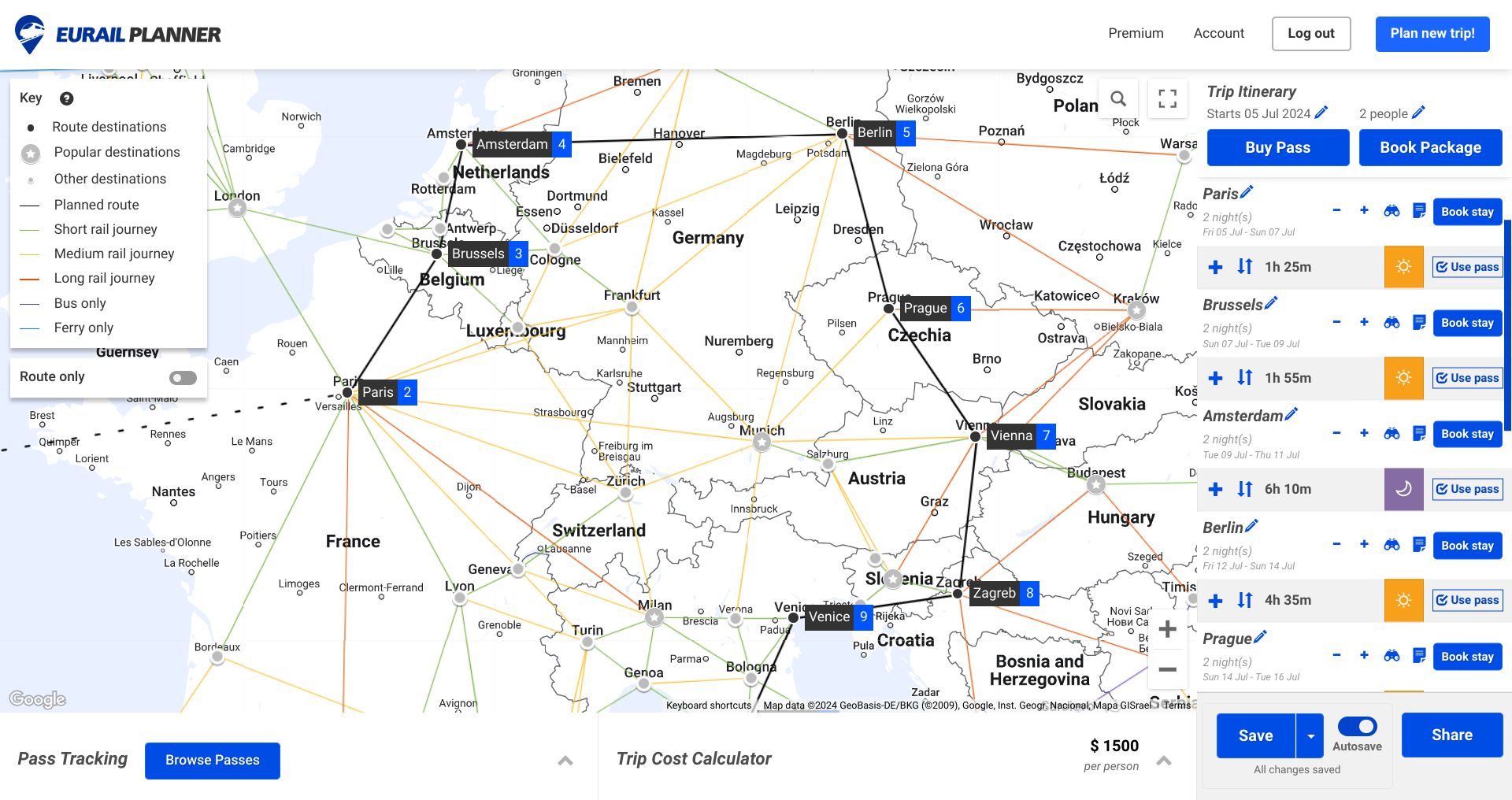
Our free app makes it easy to plan and book everything you need for your trip around Europe.
Plan the best route across Europe and see your eurotrip come to life.
See your day-by-day trip itinerary, so you know when you’ll be in each European city.
Accommodation Search
Instantly search for the best accommodation for the dates and destinations in your plan.
View durations for each rail journey on your route through Europe.
Share your plan with friends and family.
Premium Features
Unlock extra features and exclusive discounts with Eurail Planner Premium - planning your eurotrip has never been simpler.
Track your pass restrictions so you don't break the rules.
Stay in budget with a trip cost estimate that updates as you edit.
Add notes to your plan as you research your trip.
Get exclusive offers with our Premium account.
Multiple Plans
Create & save as many routes as you like.
Most popular Eurail routes
Get inspired by these popular Eurail routes. Each trip can be booked as a standard package or you can customize it and request a quote using our route planner.
Buy your Eurail pass
Whether you want to explore one country, several, or all of Europe there is a Eurail pass to suit your travel needs.

Flexi Global Pass
Travel in 33 countries with a set number of travel days in a 1-2 month period
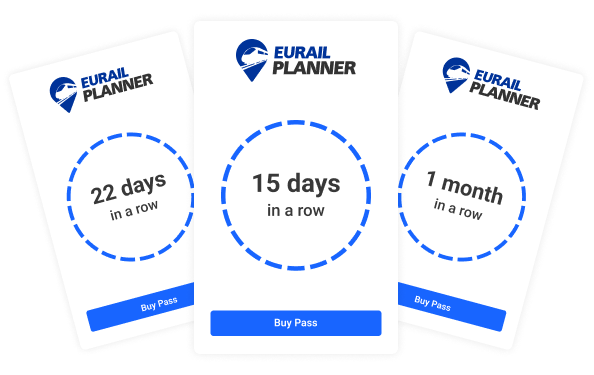
Continuous Global Pass
Unlimited travel across 33 countries for up to 3 months

One Country Pass
Delve deeper into one of 30 European countries over 1 month
Ready to plan your Eurail trip?
European Railways, Eurail Passes & Train Travel
European Rail Campaign (UK)
The Campaign for Better Rail Links to and from the UK and across Europe

Swiss Railways train in Zurich Station

Aregos Station on the Douro Line in Portugal

Austrian RailJet on the Semmering Pass

International train starts the climb up to the Arlberg Tunnel

Eurostar arrives at Albertville

Palaeofarsalos Station in Central Greece. See Travellers Tales “Into Albania and onto Greece”

The European Railway Timetable produce a stunning map of all the railways of Europe.

Intercity train Jihlava to Brno preparing to depart
European Railway Map
You can zoom in to this detailed map of the railways of Europe by using the +/- buttons or by using the wheel on your mouse whilst hovering over the map.
This map of the railways of Europe has been kindly supplied to us by European Rail Timetable Limited ( www.europeanrailtimetable.eu ). You can purchase a printed version of this map, as well as rail timetables, from https://www.europeanrailtimetable.eu/rail-map-of-europe-br-folded-576-p.asp
- European Rail News & Notes
Maps and atlases for European rail travel
Practical info.
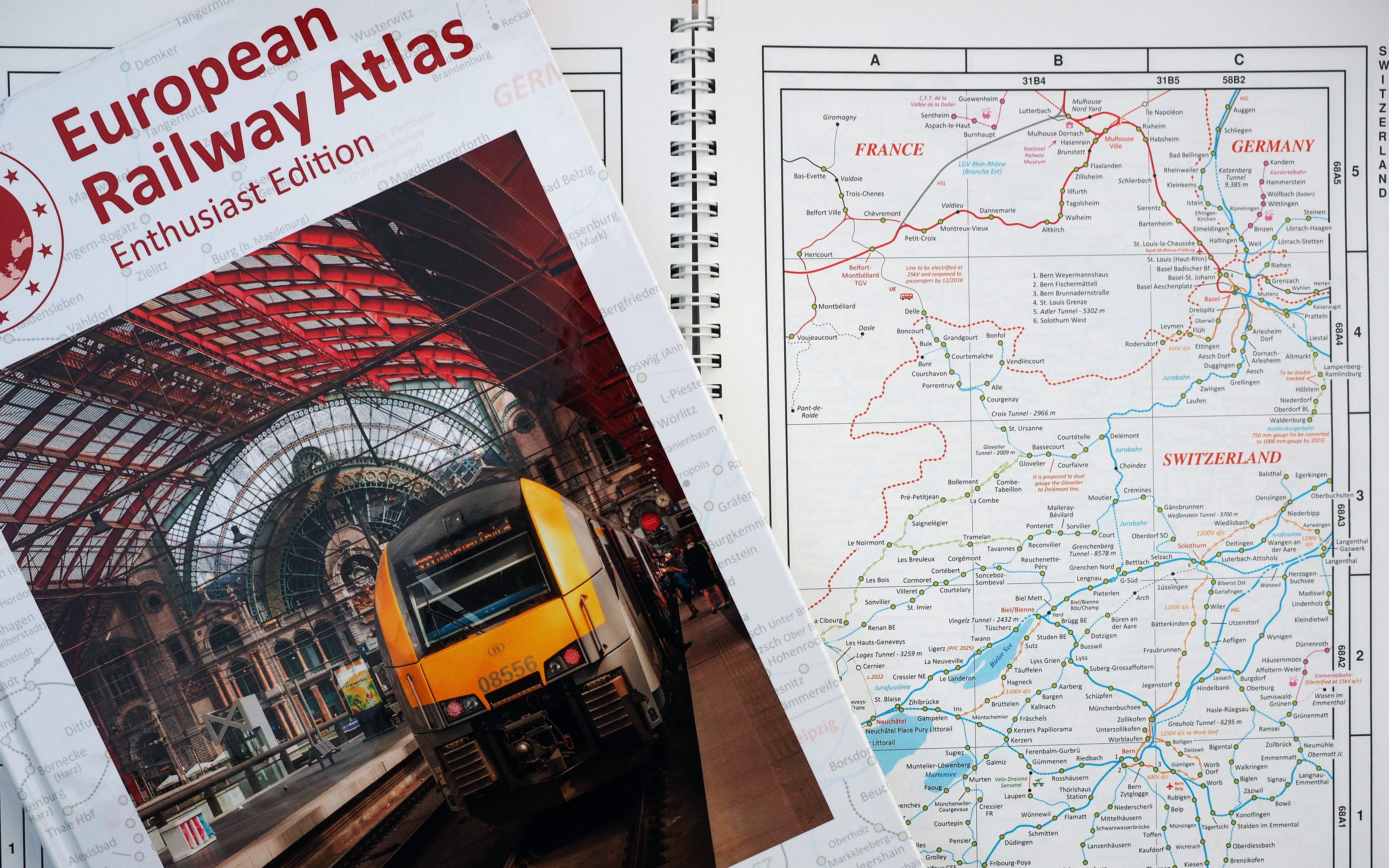
The front cover of the new Enthusiast Edition of the European Railway Atlas. In the background is a sample of the old 2017 edition which was cardback and wiro-bound. The new book is hardback.
R ailway cartography is a very specialist area. We are often asked by readers of our Europe by Rail book if there are atlases we can particularly recommend. Of course, you can find basic maps of all 53 routes in the 16th edition of the book here on this website, but we know that many readers are looking for something more.
Our top choice is Mike Ball’s excellent European Railway Atlas (ERA) which comes in various editions. But let’s first take a look at other options.
National atlases for the perfectionist
For those looking for meticulous detail, there are the excellent but very expensive national atlases created over many years by Hans Schweers und Henning Wall. The Cologne-based publisher, named after its founders, is called Schweers + Wall.
A new edition of the Schweers + Wall German atlas was released this month, and we hear that new editions of the Swiss and Austrian atlases are in the pipeline. But some of the other Schweers + Wall atlases are very dated. It’s now over ten years since the last edition of the Italy atlas. The Scheers + Wall atlases typically cost about €30 to €40 each.
A good, basic map
If you are just looking for a perfectly reliable but not especially detailed solution, then the latest edition of the Rail Map Europe , published by European Rail Timetable Ltd , perfectly fits the bill. It’s available as both a flat wall map or in a folded version. The latest version was updated in mid-2019 and is great value, typically retailing in online sales channels for about €12.
The Rail Map Europe comes with an impeccable pedigree, for it is regularly updated by the expert team who compile the monthly European Rail Timetable .
A good compromise: the ERA
Travellers looking for more detail than one might find on the Rail Map Europe might sensibly turn to the wonderful range of atlases published by Mike Ball. These are not works of great cartographic elegance since the focus of the maps is fair and square on the rail routes. Although major lakes are shown, as are national borders, there’s no topographic detail.
But Mike Ball manages to bring together in a single, reasonably priced volume extremely detailed rail maps which cover the greater part of Europe extending from Portugal and Ireland east to the western border of the Russian Federation. There are enlargements of areas with complex rail networks such as major cities and – here’s a surprise – the Donbas area of eastern Ukraine.
Mike Ball produces 14 different regional guides covering different parts of Europe in detail, showing all stations. But we really recommend the Europe-wide atlases, where there is the Tourist Edition and the even more detailed and very chic new Enthusiast Edition . The Tourist Edition is quite basic and only shows passenger lines but is ideal if your interest is planning your journeys rather than technical stuff about the railways themselves. The Enthusiast Edition does just what it sounds like, it gives all sorts of information about track gauges, electrification systems, freight lines, heritage railways and much more.
Mike Ball’s European Railway Atlas (ERA) series is perfect for journey planning, but those with an interest in maps will also find them a wonderfully entertaining diversion. There are plenty of illuminating annotations on the map. Of the line that runs east from Daugavpils in Latvia, we learn that “passenger service is limited to one overnight express.” The reader is also advised that a permanent site for a new railway station in Kiruna (in northern Sweden) is undecided. Over in Donbas, the atlas shows the front line between Ukrainian and separatist forces, noting the interruptions to rail services.
Every product, whether regional or Europe-wide, can be purchased as a printed book, as a digital PDF download or as a bundle with both printed version and the PDF. The top of the range ERA Enthusiast Edition costs about €27 for the printed book, €18 for the PDF or €33 for both together.
You can find out more about the various versions of the European Railway Atlas on its dedicated website where it is also possible to make online purchases.
History of the ERA
The European Railway Atlas has been an incredible labour of love which has been widely applauded in the rail enthusiast community. Mike Ball’s maps are extremely accurate.
Mike Ball tells us that he started what would become the European Railway Atlas in the late 1980s with the first map, covering France & Benelux, being published by Ian Allan in 1990. “Over the next few years I covered the whole of Europe west of the Russian border,” he explains.
“In those days” he says, “the books were all hand drawn on A3 art paper. The indexes had to be hand-sorted on little bits of paper and then carefully typed up, until the advent of the little Psion 3 pocket computer simplified the process.”
But there were challenges. Mike recalls that “trying to accommodate the publisher’s deadlines at the same time as doing my real job as a train driver had turned a hobby into a chore.”
That would probably have been the end of the ERA, but for developments in technology. “Desktop publishing, digital cartography and the internet have changed things,” comments Mike. “These days I no longer drive trains, so with more time I can sit at home drawing the maps on computer, publishing them myself and selling them on my own website.”
Developments in communications have helped too. “Now I am in touch with experts right across Europe who are very kind in feeding information and making suggestions and corrections,” explains Mike. “Without that rich network of contacts, the ERA you see today could not exist. Looking back I can’t imagine how I ever got as far as I did without them! Ultimately, though, I recognize that the ERA is a niche product that’s never going to make a big profit.”
About The Authors
Nicky Gardner and Susanne Kries
Nicky and Susanne manage hidden europe , a Berlin-based editorial bureau that supplies text and images to media across Europe. Together they edit hidden europe magazine. Nicky and Susanne are dedicated slow travellers and the authors of the book Europe by Rail: The Definitive Guide . The 17th edition of that book was published in 2022 and reprinted in July 2023. You'll find a list of outlets that sell the book on this website.

Francesca Whittlestone, 7 December 2020
Can i buy the European Railway Atlas (ERA) asa book ? thank you
Add a comment
Latest posts.

About Newslines
Every month, the new edition of the European Rail Timetable (ERT) includes an invaluable section called Newslines , which highlights significant new developments in European rail travel. The latest Newslines can be downloaded below. Earlier issues can be found here .
Latest Newslines
- ERN Newslines Apr 2024
- ERT Newslines Mar 2024
- ERT Newslines February 2024
Latest tweets
You might also enjoy reading.
- UIC on Twitter
- UIC on LinkedIn
- UIC YouTube channel
- UIC on Pinterest
- UIC on Instagram
- RSS feed (latest updates)
- Railway Publications
- previous article
- back to eNews
- next article
Just published: A Travellers’ Railway Map of Europe
UIC has received the new Travellers’ Railway Map of Europe from Dutch editor Carto Studio BV. The map is designed for travellers who wish to discover Europe by train.
In order to facilitate the use of this map, the railway network is classified into several categories: high speed lines, main lines, and secondary and tourist lines. Scenic routes and major tourist highlights are also clearly marked on the map. For dense regions, detailed railway maps are also provided.
More details about the Travellers’ Railway Map of Europe are available at the following website: http://www.railwaymapeurope.com/ /moc.eporuepamyawliar.www//:ptth’)]

Rail map of Europe
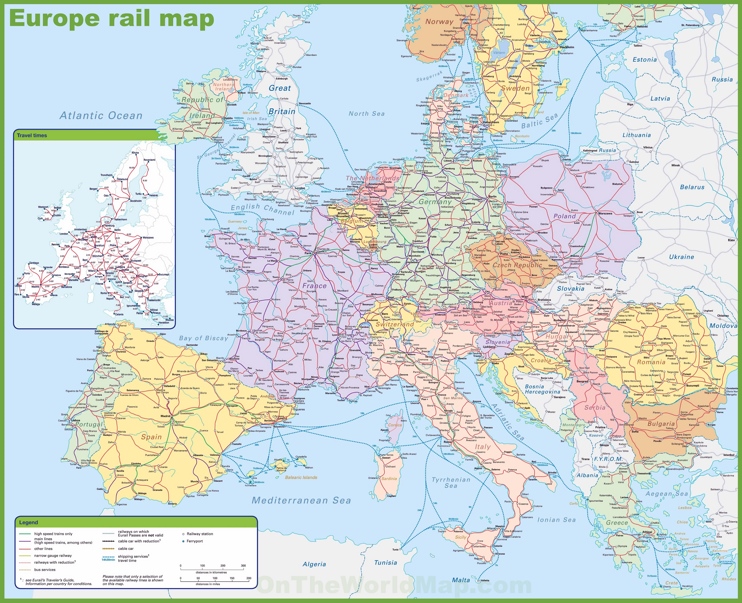
You may download, print or use the above map for educational, personal and non-commercial purposes. Attribution is required. For any website, blog, scientific research or e-book, you must place a hyperlink (to this page) with an attribution next to the image used.
- North America Map
- South America Map
- Oceania Map
Popular maps
- New York City Map
- Los Angeles Map
- Las Vegas Map
- Australia Map
- Germany Map
- Netherlands Map
- Singapore Map
- United Arab Emirates Map
- United Kingdom Map
- United States Map
U.S. States
- Arizona Map
- California Map
- Colorado Map
- Florida Map
- Georgia Map
- Illinois Map
- Indiana Map
- Michigan Map
- New Jersey Map
- New York Map
- North Carolina Map
- Virginia Map
- Wisconsin Map
Your browser is not supported
Sorry but it looks as if your browser is out of date. To get the best experience using our site we recommend that you upgrade or switch browsers.
Find a solution
- Skip to main content
- Skip to navigation

- Back to parent navigation item
- Traction & Rolling Stock
- Infrastructure
- Research, Training & Skills
- Accessibility & inclusion
- Coronavirus and the rail industry
- Australasia
- Middle East
- Central & South America
- North America
- UK news from Rail Business UK
- Urban transport news from Metro Report International
- Light Rail & Tram
- Suburban & Commuter Rail
- Peoplemovers & Monorails
- Maps & Data
- Railway Operators
- Train Operator / Open Access
- Track Authority
- Holding Company
- Urban Railway Operators
- Light Rail / Tramway
- Infrastructure/Track Authority
- Urban rail - list of openings
- Country and city map directory
- Country Profiles
- Regulatory Authorities
- Associations
- Data & Analysis
- Supplier Profiles
- Rail Industry Events 2024
- Rail Industry Events 2025
- Rail Broadcast Week
- Rail Business Awards
- Rail Training & Skills Courses 2024
- Digital Magazines
- Railway Gazette International
- Metro Report International
- Tenders & Jobs
- Sponsored content
- White Papers
- Digital Advertorials

- More from navigation items

A Travellers' Railway Map of Europe
By Railway Gazette International 2011-06-05T04:00:00+01:00

EUROPE: Dutch cycling map publisher Carto Studio has published a map of the European railway network which is says aimed at 'people who like to travel by train and who would like to follow their own journey throughout Europe.'
The rail network is projected onto a relief background. Lines are shown in categories, including high speed, main, secondary and tourist lines. Tunnel names are given and scenic routes and tourist highlights marked, along with main stations.
The 690 x 990 mm double-sided map includes overview maps of Europe, Scandinavia and Eastern Europe, and larger scale coverage of northwest mainland Europe, Switzerland and northern Italy. There are city maps of Barcelona, Berlin, Brussels, Budapest, Dublin, London, Lyon, Milano, Paris, Praha, Roma and Wien, showing a selection of attractions and metro stops.
€12·50 + postage from Carto Studio BV/Benjaminse Uitgeverij, Leidsestraat 32, 1017 PB Amsterdam, Netherlands
- Book reviews
Related articles

Le Monde a Grande Vitesse
2019-12-01T05:00:00Z
Launched at the headquarters of the International Union of Railways in Paris, this book on high speed railways by Marie-Pascale Rauzier and François Schuiten has been prepared by Casablanca-based publisher Langages du Sud. In 232 pages it describes 21 high speed rail routes, starting with Tokyo – ...

Losing Track
2019-11-27T05:00:00Z By Rail Business UK
Subtitled ‘an insider’s story of Britain’s railway transformation from British Rail to the present day’, this ‘semi-autobiographical’ book by John Nelson reflects on how Britain’s passenger railway has evolved over the past 50 years, with a view to informing the current Williams Review into the future ...

Overhead Line Electrification for Railways
2019-03-15T17:18:40Z By Rail Business UK
Book Review Overhead Line Electrification for Railways By Garry Keenor Developed over several years by an experienced electrification engineer, this book is intended to provide ‘an approachable and reasonably comprehensive’ study of overhead electrification systems, setting out ‘the why as well as the what’ for readers with some basic engineering ...
- Advertising
- Terms and Conditions
- Cookie Policy
- Privacy Policy
- Archive (by date)
- © DVV Media International Ltd
Site powered by Webvision Cloud
Where can you go by train in 8h?
This map shows you how far you can travel from each station in Europe in less than 8 hours.
Hover your mouse on the map to see the isochrones from that city, search for a station, or click on one of the examples below.
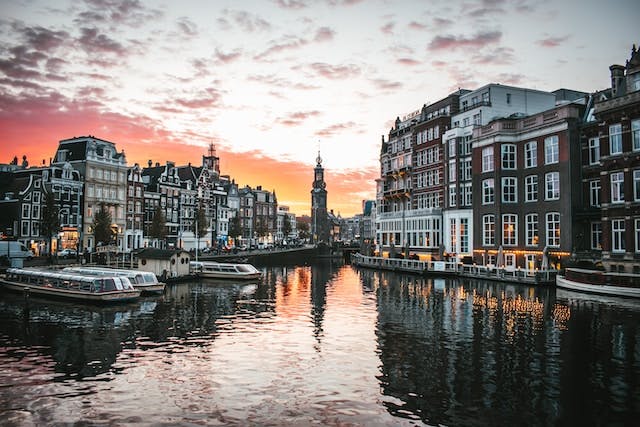
This map is based on estimated travel times, using data from the Deutsche Bahn through Direkt Bahn Guru . Actual timetables may vary.

Effective Europe train travel planning with Eurail & Interrail map
Europe Train Passes Eurail & Interrail Map
If you are pondering over getting a Eurail or Interrail Pass for your next European adventure, you owe it to yourself to make sure that the pass is just the right fit for you. The first step to getting the maximum value out of your pass includes a bit of planning. And trust us, planning is half the fun of any trip. And that’s where a Eurail & Interrail map comes handy. As much as we would love to play detective, bring out our magnifying glasses and survey a big sheet of map, we’ve got something better for you - an interactive Eurail and Interrail map that is easy to understand and use.
Plan your journey with Eurail & Interrail map
This Eurail & Interrail map has all the big city train connections in Europe. Play around with the map and figure out the routes you intend to take and learn about the average travel time. Make a rough cost estimation of point-to-point tickets and compare it to the Eurail or Interrail Pass price, to identify if the pass is ideal for you.
However, do keep in mind that it's not just cost-savings that make the Eurail & Interrail Pass so popular but also the immense flexibility it lends to your travel plans. As opposed to the rigidity of point-to-point tickets, with the Eurail or Interrail Pass, you can simply turn up at the station and decide to take the next train that comes along. Additionally, planning the routes beforehand will also help you choose the most apt Eurail or Interrail Pass. Dive deep and find your primary travel routes below.
How to read the Eurail & Interrail Map?
- All the bigger European cities and train connections between them are mapped above. Keep in mind that Eurail or Interrail Pass is not limited to these train journeys.
- Click on the station icons to see the city name.
- Click on the lines connecting the cities to find the average train travel time between them
Frequently asked questions
Can i use the eurail or interrail pass in all european countries.
Eurail and Interrail Pass can be used in 33 European countries . To explore a single country, choose a single country pass and if you plan to go country-hopping, choose a Eurail or Interrail Global Pass.
What is the difference between Eurail and Interrail Pass?
The only difference between Eurail and Interrail Pass is the kind of travelers it targets. Eurail Pass can be used only by non-European residents, whereas Interrail Pass is for the specific use of European residents.
Can I customize my route based on my preferred destinations with Eurail or Interrail Pass?
The best thing about Eurail & Interrail Pass is that it is totally customizable. Decide the routes you intend to take using our interactive Eurail & Interrail map and simply add those journeys to your pass and get going!
How do I check train schedules and plan my itinerary accordingly?
You can find the train schedules on the Rail Planner App and select journeys as per your requirement. If you want to know the average duration of the journeys connecting main European cities, click on the lines connecting the two cities on the Eurail & Interrail map.
What are some tips for maximizing the use of my Eurail or Interrail Pass?
Planning ahead and choosing the right pass is the first step to maximizing the value of your Eurail or Interrail Pass. The main premise of the Eurail or Interrail Pass is that the more train travel you embark on, the more value you make of it.
Are there any scenic Eurail or Interrail routes that I should consider?
Europe teems with scenic train routes and many people often embark on train journeys just for the view. Bernina Express, Glacier Express and the Golden Pass Scenic Train in Switzerland, Rhine Valley Line in Germany, Flam Railway in Norway are just a few of our recommendations.
What are some popular Eurail or Interrail routes?
Rome to Florence, Paris to Rome, Madrid to Barcelona, Vienna to Budapest are a few popular routes covered by a Eurail or Interrail Pass.
Maria Philip
Every friend's gang has that one friend who plans the trip, finds cute little spots to explore great views and food, and keeps cool trivia handy. I am that friend. I like to know before I go, keep things under budget, and help others do the same through my writing. Someone once said, ‘Traveling makes you a storyteller’ and it stuck with me to do more traveling and telling. You will find me the happiest in quiet spots under thick green canopies, over a delicious spread of my comfort foods, or while loudly singing my favorite tunes, or engaging in silly banter with friends and family, or on the window seat of a moving bus or train with music plugged in. The list is longer, but you get the gist!
Be a smart traveler
The first to know about trending destinations, travel deals, tips and all things travel.

Taking the train in Spain - all you need to know

Apr 3, 2024 • 15 min read
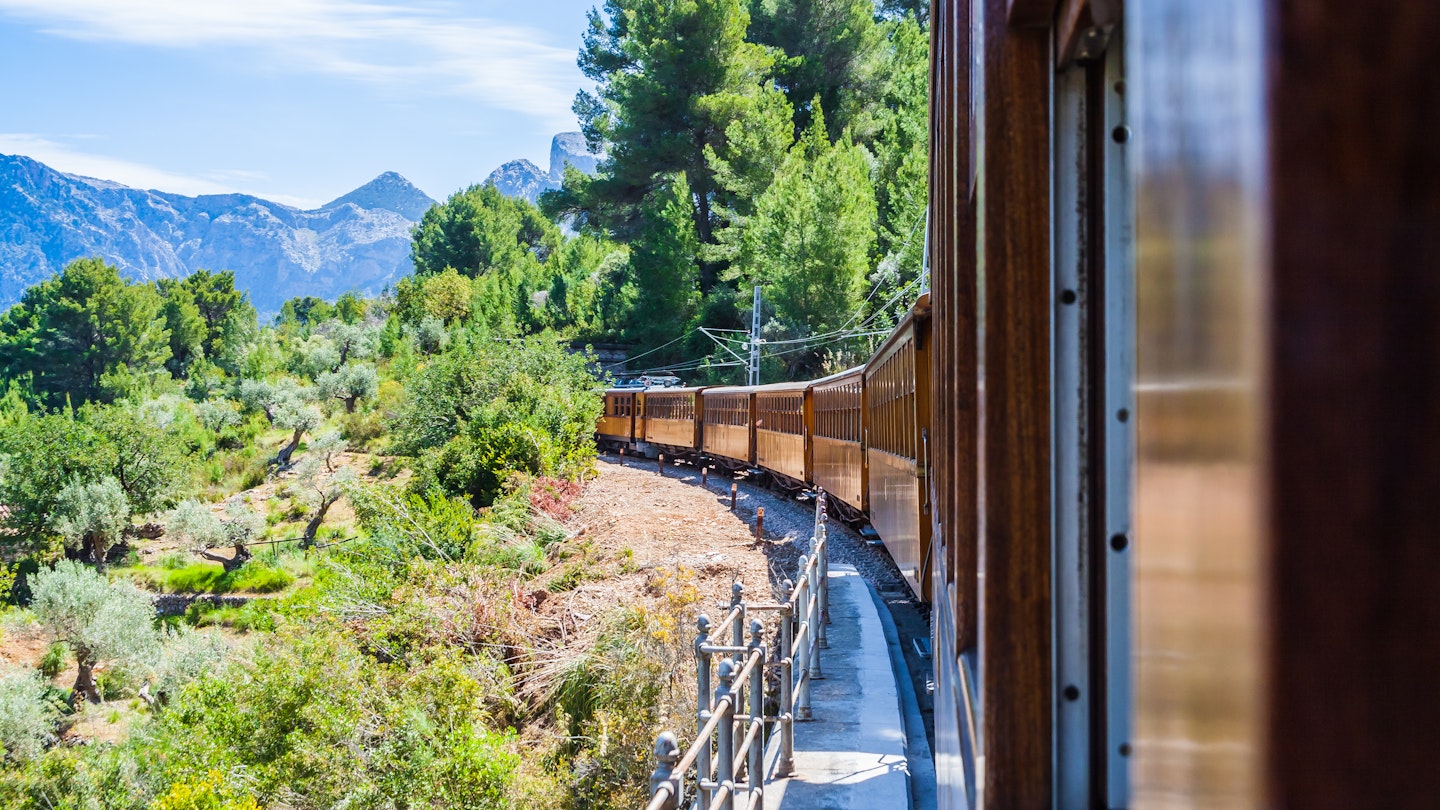
The vintage train from Sóller to Palma de Mallorca is one of the most scenic rail routes in Spain © Shutterstock
Spain boasts Europe’s longest high-speed rail network, second only to China globally, and its trains are exceptional and far-reaching. In one day, you could gawp at Gaudí’s architectural genius in Barcelona , be whisked by rail to Madrid ’s museums, and still arrive in Seville for a sunset flamenco show.
Not that it’s all A to B whirlwind rail routes. There are some outstanding scenic train journeys to slow down and enjoy the Spanish pace of life, whether trundling along the northern coast’s narrow-gauge tracks or meandering into the mountains. And with some new low-cost operators now on the scene, exploring Spain by train has never been more affordable.
With over a thousand stations and thousands more daily departures, getting around Spain by train is a straightforward joy rather than a stressful necessity. Seat reservations on most services guarantee uncrowded carriages, Rioja-serving cafe cars provide perfectly wine-paired panoramic views, and electric-powered trains make journeys even more sustainable. What’s not to love? Here’s everything you need to know to plan a train trip in Spain like a pro.
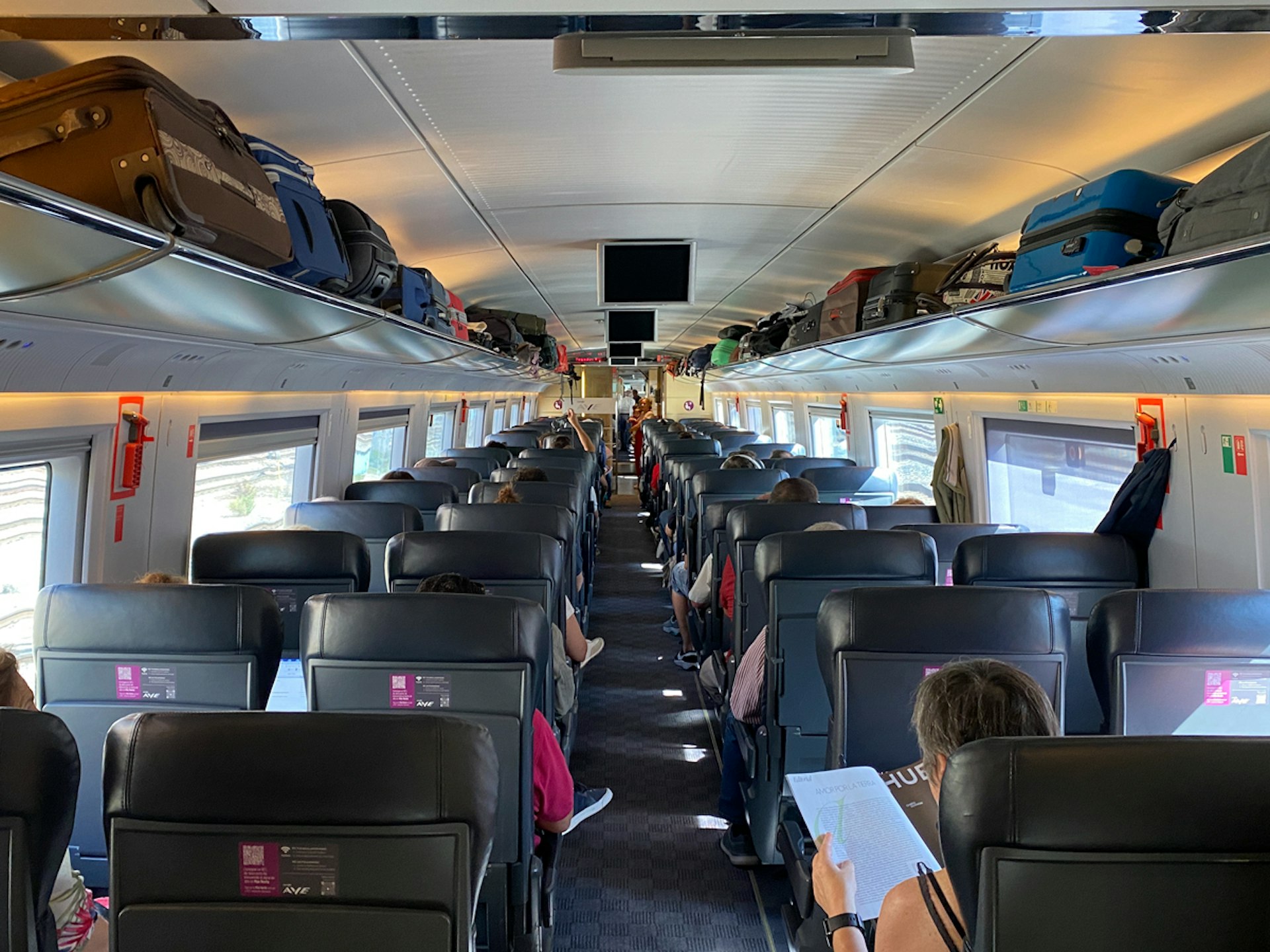
Train services are generally excellent in mainland Spain
You can traverse all four corners of Spain by train, usually on swift, reliable, well-maintained carriages. Few areas aren’t covered by at least a regional service. And where there are coverage gaps, buses will usually take you the final stretch to that pretty medieval village. While strikes can occur, they are rare, and minimum service levels are generally guaranteed. Compensation payments are offered for delays over one hour, which helps keep timetables on track.
Renfe is Spain’s national railway company, operating everything from non-stop regional capital connections to short-hop commuter services. Iryo and Ouigo provide low-cost competition on the main high-speed intercity lines, with the latter’s double-decker trains being a welcome addition.
While the numerous names for differing service and train types can be confusing, the trains in Spain can generally be divided into three categories:
- High-speed, mainly long-distance (larga distancia) services link many major cities, mainly via Madrid. These full-service trains can reach 310km/h (193mph) and include Renfe’s AVE (Alta Velocidad Española), its new no-frills Avlo counterpart, and Iryo and Ouigo. There’s an ever-growing network of high-speed routes , including the popular Barcelona–Madrid, Madrid–Seville, and Madrid–Valencia lines.
- Mid-distance services – although they can sometimes cover long distances and reach speeds of 250km/h (155mph) – make up the majority of other major routes. Renfe services these under names including Media Distancia, Avant and Alvia. Intercity and Regional Exprés services are somewhat slower but only call at major stations. Popular routes include Madrid– Toledo , Granada–Seville, and the Euromed coastal service between Barcelona and Alicante . Nearly all long and mid-distance services use sleek, modern carriages.
- Slower trains , including Regional, Proximidad, and Cercanías commuter services (Rodalies in Catalonia), complete the network. The older Cercanías AM trains, previously FEVE, mainly operate on the northern coast’s picturesque narrow-gauge tracks.
Nearly all large and medium-sized train stations are staffed and contain shops or cafes. High-speed train stations operate similarly to airports, with luggage security scanners and boarding gates. It’s advisable to arrive 20–30 minutes early, especially as boarding can close five minutes before departure. The bonus is you’ll have time to admire the stations. Some, like Toledo’s Mudejar-style ticket hall and art nouveau Bilbao Concordia , are attractions in their own right.
There are tourist trains and unique rail services too
In addition to standard train services, Spain has an exceptional selection of specialist rail routes known as “ tourist trains .” These range from seasonal, short routes, such as the scenic Tren dels Llacs in the Pre-Pyrenees, to indulgent, multiday sojourns like the luxury Transcantábrico train hotel. There are currently no standard domestic night trains.
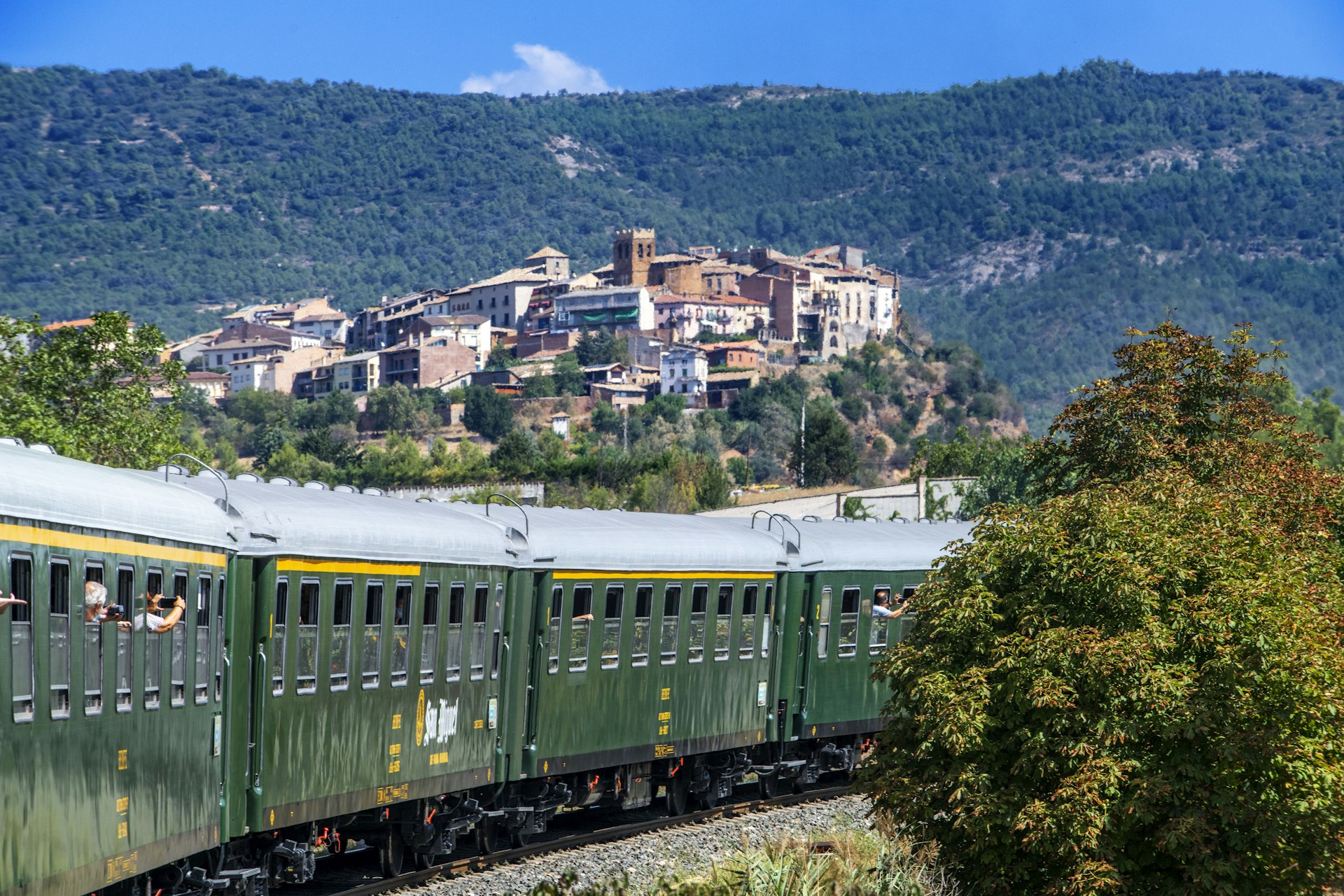
International and island rail routes are limited
Away from the mainland, the rail situation is starkly different. The Canary Islands have no train services, and only Mallorca in the Balearic Islands has limited rail connections . These consist of three short, modern lines and the vintage Sóller train.
Traveling to and from France by train is possible on France’s TGVs (from Paris) and Renfe’s International AVE services to Marseille and Lyon . Fares start from €29. You can also cross via Hendaye in the Basque Country or take the slower, scenic sleeper service via the Pyrenees . The Trenhotel (night service) between Madrid and Lisbon has been discontinued, leaving the Tren Celta between Vigo and Porto and the slow route to Lisbon via Badajoz as the only connections with Portugal . Work continues on improving the tracks to accommodate a direct, high-speed link between the two Iberian capitals.
Book ahead to save money and guarantee your seat
Spain’s rail operators all use dynamic pricing for high-speed and long-distance services. Therefore, early booking is advised, especially as seat reservations are mandatory. Advanced Avlo tickets between Madrid and Barcelona start from €7, with Ouigo and Iryo also offering competitive pricing on primary routes. A same-day ticket can sometimes cost more than 10 times more than booking in advance. Prices are less competitive on routes solely operated by Renfe.
When booking tickets online to or from major cities, use the dropdown city name followed by todos (all) to check for direct and affordable tickets from all stations. Provide the Passport or ID number of the photo document you’ll be traveling with, as tickets are personal. The second surname can be left blank – Spanish people take both their father's and mother’s surnames. Tickets can be printed, collected at self-service machines, or displayed as QR codes on mobile devices. Overall, Ouigo and Iryo's websites are easier to navigate than Renfe's, which can be glitchy. While most people would recommend using a third-party booking service – handy for comparing prices between all operators – direct reservations avoid booking fees.
Even short-distance, popular services with fixed fares (some mid-distance and regional trains) can fill up. I’ve previously struggled to get last-minute weekend tickets on the Madrid to Toledo route. Secure all tickets ahead if your vacation coincides with a major holiday such as Easter (Semana Santa) or Christmas, including around Three Kings Day on January 6.
Iryo and Ouigo release tickets many months ahead. Renfe’s tickets should be available at least 60 days ahead, but this isn’t always true. Check regularly in the months leading up to your departure and sign up for newsletters on the three websites to receive ticket availability and discount updates.
Occasionally, two single fares (ida) can be cheaper than a return (vuelta) . Reservations can also be made at station ticket machines (in English) or staffed desks. Larger stations may have separate sales points for particular types of tickets.
You’ll always be assigned a mandatory seat reservation. However, if you’d prefer to select your own to guarantee a window, you can change it for a nominal fee. Confusingly, Renfe’s website has this step after choosing a payment method.
Cercanías and Cercanías AM tickets can’t be purchased in advance and should be purchased at the ticket office, self-service machine, or onboard from the conductor when traveling from the tiniest unstaffed stations. This is the only time you’re allowed to board a train without a ticket.
If you wish to upgrade from basic class (básico) on high-speed routes, you can choose from Elige, Elige Confort and Prêmium on Renfe, or similar options on Iryo. Upgrades can include access to premium station lounges, at-seat food service, and more spacious seats. Solo travelers may want to upgrade to enjoy an individual seat in the 2+1 configured carriages. Ouigo allows these seats as a paid add-on without upgrading.
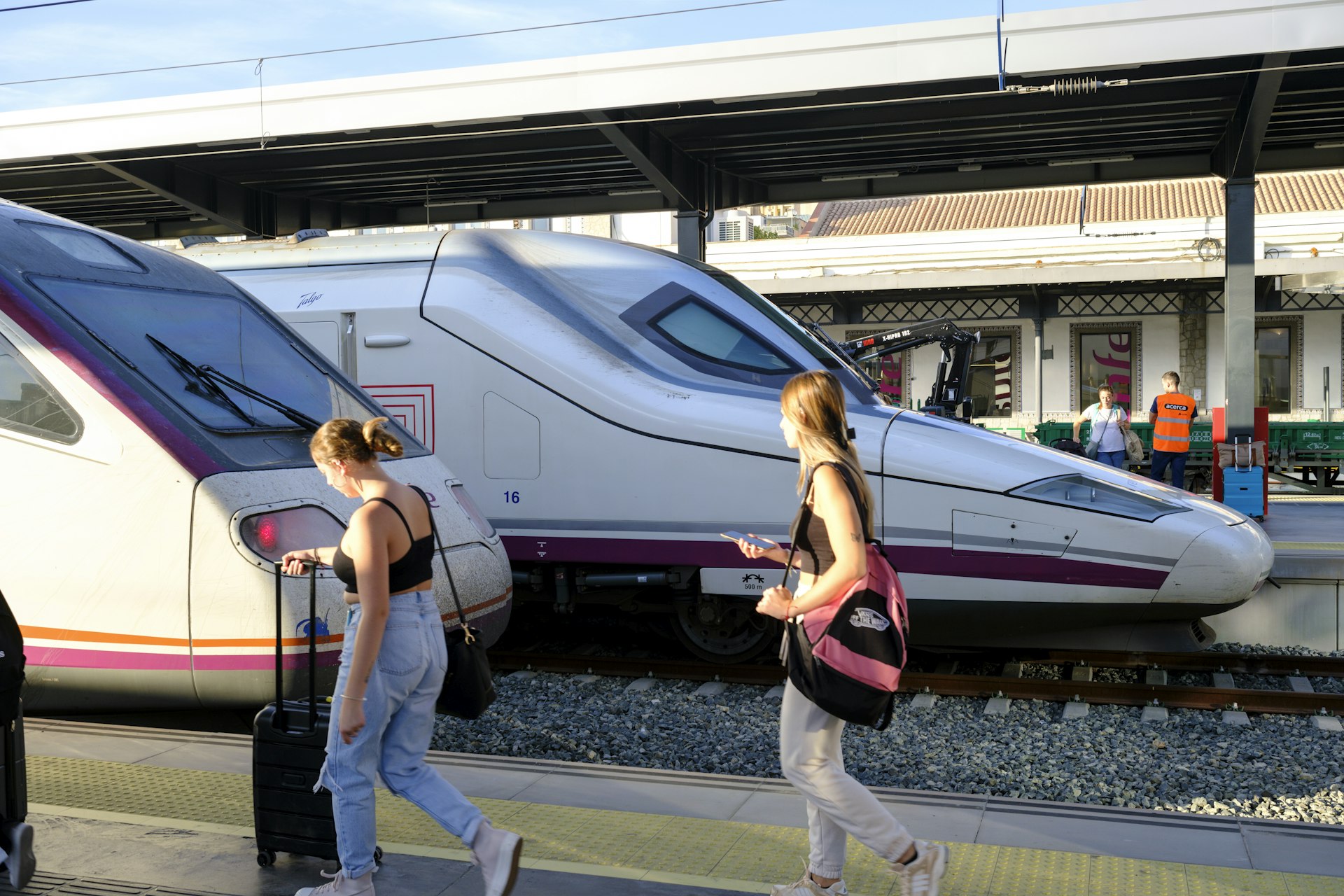
Discounts and offers: know your benefits and bring ID
Much noise was made about the launch of Spain’s fixed-price travel pass . Yet this system, established to offer discounted fares on repeat return trips, is primarily aimed at locals and commuters.
Renfe does offer a Spain Rail Pass for travelers , covering between four and ten journeys. However, depending on the routes you plan to take, pre-booking discounted, advanced fares can be cheaper. Some region-specific options exist, such as the better value three-day Galica Rail Pass .
Other discounts available on Renfe include:
- Small group discount when booking four or more travelers together.
- Seniors discount, up to 40%, for over 60s. However, this requires purchasing a card ( La Tarjeta Dorada ) in person before making the reservation. Advanced, discounted fares can be better value.
- Youth Discounts for under 25s with a European Youth Card or suitable International Student Card. A digital card can be purchased online by citizens of most countries.
- Babies travel for free, as do children, although the age cap varies between operators.
Considering an Interrail or Eurail pass? Check on any savings first. All high-speed trains in Spain require seat reservations, an additional cost not included in these passes. Avlo, Iryo, and Ouigo are likewise excluded, and these cheaper advanced tickets may be better value than using the pass, though there is less flexibility.
Money-saving tip: high-speed trains include a free local ticket
If you’re traveling on a high-speed AVE or long-distance service operated by Renfe or Iryo, Combinado Cercanías is included. This allows for free use of local Cercanías trains to reach your departure station and again on arrival. Scan the QR code at barriers, or use the PDF code to get a zero-priced ticket at Cercanías’ self-service machines.
Seat reservations ensure most train journeys don’t feel crowded
Traveling by train in Spain is so enjoyable because all long and mid-distance services require a seat reservation. With no congested corridors or jostling vestibules, these trains never feel crowded, even when full. However, some regional and Cercanías services can be packed, particularly around commuter hours and Friday and Sunday evenings. You might want to avoid peak times or, when available, pay for a regional service seat reservation.
Plan around major events and regional holidays during your trip, such as Semana Santa, when ticket demand and crammed suburban trains are common. Trains in Spain operate every day of the year, though some services may finish earlier on public holidays. If you’re traveling on weekends or during holidays, check onward public transport in advance as small, rural stations may have a reduced weekend bus service.
Train can be the fastest, most affordable transport method
Using the train in Spain can be quicker and cheaper than flying. For example, a flight from Madrid to Barcelona takes 1¼ hours compared with 2½ hours by high-speed rail. But once you factor in security checks, out-of-city airport transfers, and runway taxi times, the overall journey length by plane becomes longer.
Driving distances are considerable. The same journey by car will take closer to seven hours. It’s unquestionably worth renting a car if you’re planning a road trip , but generally, long-distance jaunts are best by rail.
Most train terminuses are connected to city buses and, in larger metropolises, commuter rail or metro systems. Barcelona-El Prat Airport and Madrid–Barajas Airport are on the train network. If you wish to visit smaller towns or villages that are not on the train network, consider other ways to get around Spain .

Onboard facilities differ between service types
All of Spain’s high-speed train services are spacious, comfortable, clean and well cared for. Carry-on luggage can be placed in overhead racks, while storage areas at either end of the carriage accommodate bulkier luggage. Popular services (especially on Friday and Sunday evenings) can quickly fill, and train staff will usually assist in rearranging suitcases to fit. Cercanías services can be more dated and crowded and often lack enough dedicated luggage space.
If you’re traveling by bicycle, check the luggage policies of Renfe and Iryo . In some instances, bikes must be disassembled or an additional fee paid.
The dining carts on Spain’s trains are typically stand-up, cafe-style rather than seated dining carriages. They’re good for stretching your legs or getting an alternative window view, but dining at your seat table is often more comfortable. A selection of hot meals, snacks and drinks – usually all of decent quality – are available, and certain ticket types offer pre-ordered meals served at your seat. Iryo has particularly impressive dining options .
On some routes, a trolley service may be provided in addition or as an alternative. Mid-distance and Avlo services have vending machines rather than dining carts. Bringing your own food and even alcohol onboard Renfe’s services isn’t a problem.
Complimentary (sometimes patchy) wi-fi is provided on Iryo and Renfe’s high-speed services, alongside entertainment portals accessible on your device. Ouigo charges per connection. Plug sockets (F-type) are available at seats on high-speed and mid-distance trains. Nearly all trains, except commuter services, have toilets.
Plan the perfect train trip with these scenic routes and tips
The most popular train routes for travelers in Spain are the high-speed connections that rocket between Seville, Madrid, Barcelona and Valencia. But riding the rails in Spain isn’t only about barrelling between urban sprawl. These are some of our favorite scenic rail routes worth planning into your trip.
- Santander to Oviedo : Cross the lush landscapes of Northern Spain on this slow, scenic rail route using Cercanías AM’s narrow-gauge tracks. This six-hour journey provides some of the expensive Transcantábrico Train’s panoramas for a bargain €16.55. There are no seat reservations, which is handy, as you can switch sides to marvel at both the sparkling Bay of Biscay and the mighty Cantabrian Mountains , Spain’s answer to the Dolomites.
- Barcelona to A Coruña : Once served by the discontinued sleeper Trenhotel, this is one of Spain’s longest rail routes, taking nearly 14 hours. The 9:05am Alvia departure can be affordable to cross seven of Spain’s autonomous communities. Pack snacks and pay for a window seat (ideally on the right) to see the full scope of Spain’s landscapes, from arid pastures and fertile farmlands to the verdant Galician Massif . Consider hopping off a few stops early in Ourense to use the town’s free-to-access thermal pools the following morning.
- Granada to Almería : Leaving the magnificent Moorish Alhambra behind, set off across western Andalucía towards the coastal city of Almería. It’s a showstopping three-hour journey traversing the foothills of the Sierra Nevada, snow-capped peaks looming beyond, before cutting through carpets of cork trees. Book a late afternoon departure for ethereal golden light, or take two single tickets to plan a lunch pause at Guadix, best known for its cave houses.
- Palma de Mallorca to Sóller: Step onboard the rickety, wooden carriage of Ferrocarril de Sóller , constructed in 1912, for a one-hour-long trundle from Mallorca's capital to the pretty port town of Sóller. En route, you’ll wend through the Tramuntana Mountains, unlit tunnels, and citrus groves close enough to touch. All seats are excellent, but you might want to stand in the open-air platforms between carriages.
- Zaragoza to Canfranc : A one-way ticket on this twice-a-day, 2½-hour regional train costs just €16.90, and you’ll get plenty of panoramas for your money, especially after Huesca when the tracks slowly climb up into the Pyrenees. Our resident rail expert, Tom Hall, calls it one of Europe’s best train routes , partly because the landmark Canfranc Station has recently been reborn as a grandiose hotel .

Station tips when traveling Spain by train
Most large cities have multiple train stations, so always confirm departure points. When traveling to dedicated AVE stations outside major cities, check the station’s distance from the city center and pre-plan your connecting travel. Some stations, such as Antequera ’s Santa Ana, can be as far as 15km (9 miles) from the Old Town.
Spain’s largest stations, such as Madrid Atocha and Barcelona Sants, can be confusing due to split-level and separated boarding areas for different services. Don’t be afraid to ask for help navigating the station. A quick flash of your ticket will soon have you pointed in the right direction.
All major stations have cafes and kiosks where you can pick up food, although preparing a train picnic from a delicatessen might be preferable. Still, a quick tapas in Atocha's Tropical Garden, even if the pond-residing turtles have now been rehomed, is a solid start to any journey. If you’re on a connecting service with time to explore beyond the station, most larger terminals have lockers or left luggage desks (consigna) .
Many stations are accessible, but there’s room for improvement on older services
Adif, the agency in charge of Spain’s rail infrastructure, provides in-station and boarding assistance for travelers with accessibility needs via the Acerca service, offered at 145 stations.
When booking tickets online, H seats – accessible spaces that can anchor a wheelchair – can be requested on the opening screen, and Acerca assistance can be requested later in the booking process. A minimum of 12–48 hours' notice is stipulated, depending on the operator. However, in larger stations, staffed service centers can usually provide support without pre-booking if you arrive and register at the desk ahead of travel. Check which facilities are available at each station on Adif’s website .
In addition to offering boarding support (many train types require a stair-climber lift, not just a ramp, while others like Avlo have level boarding), Acerca can provide technical aids for hearing and a guided sight service. Contact Adif Acerca for information on induction loop systems or to discuss alternative routes should your planned journey include a non-accessible station without in-person assistance. Tactile paving, step-free access, and elevators are installed at most major stations, and nearly every train has a conductor or staff member onboard who can assist.
On high-speed, long-distance, and most other services, wheelchair-accessible bathrooms are located in carriages with H seats. Ouigo trains have a call button on adapted seats to provide food and drink service, as the cafe is located on the top deck. Cercanías AM carriages have no H seats but offer a dedicated space for wheelchair users with tie-downs. However, many older, narrow-gauge trains lack accessible bathrooms.
Explore related stories
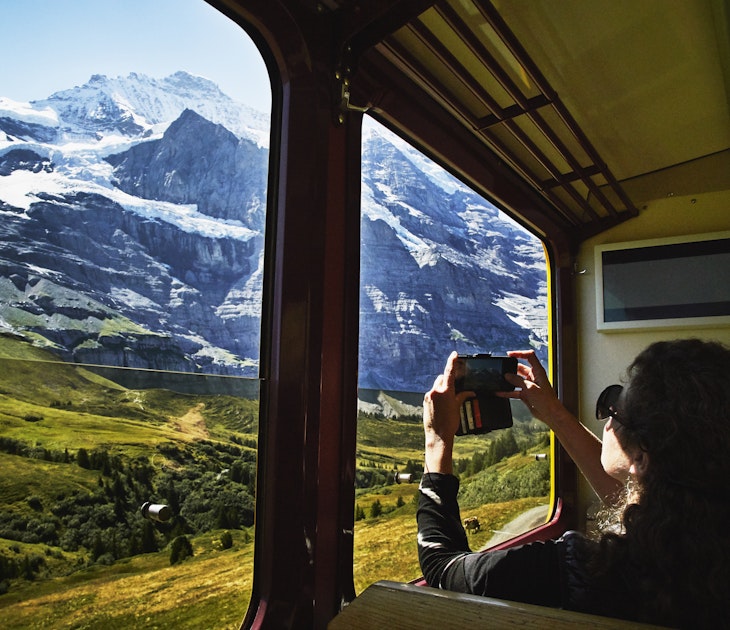
Sustainable Travel
Jan 16, 2024 • 8 min read
Rolling forests, saw-toothed mountains, bridges spanning river gorges - these European train rides put on quite a show.

Dec 25, 2023 • 11 min read

Dec 19, 2023 • 6 min read

Nov 1, 2023 • 4 min read

Oct 19, 2023 • 8 min read

Oct 6, 2023 • 8 min read

Jun 26, 2023 • 5 min read

Jun 18, 2023 • 6 min read

May 19, 2023 • 12 min read

May 5, 2023 • 7 min read
Best night trains in Europe
Growing in popularity, sleepers offer the perfect combination of travel and accommodation in one
- Newsletter sign up Newsletter

Long-distance train travel is having a moment it seems. Whether the appeal is the old-school romance of being rocked to sleep on the rails, perhaps waking up in another country, concerns about climate change and the carbon footprint of flying, or a desire to experience slow travel and take in more of your surroundings on your journey, a sleeper train offers the perfect combination of travel and accommodation in one.
Taking a night train across Europe "is an exceptionally convenient, efficient and budget-friendly way to explore the region", said Rail Europe . That's because the price of your ticket also covers the cost of a night's accommodation. "So take the money you would have spent on a hotel and add another leg onto your trip or splurge at your next destination."
Here are some of Europe's best night train journeys.
Subscribe to The Week
Escape your echo chamber. Get the facts behind the news, plus analysis from multiple perspectives.

Sign up for The Week's Free Newsletters
From our morning news briefing to a weekly Good News Newsletter, get the best of The Week delivered directly to your inbox.
London to Venice
The Venice Simplon Orient Express is the "grand dame of sleeper trains", said The Times . Since being immortalised by Agatha Christie it's "become the byword for yesteryear elegance", as "one of the few surviving chariots of the golden age of travel". Luxe to the max, its interiors feature "wood panelling and lush drapes, antique lamps and art deco mirrors, and a Bar Car with live music". If money is no object, "splash out on one of the six grand suites for marble en suites, butler service and as much champagne as you can glug". Nowadays, you travel from London Victoria "aboard the luxury private Belmond British Pullman" to Paris, before joining the Orient Express for the overnight leg to Venice.
Find out more: belmond.com
Trondheim to Bodo
"Under normal circumstances, the jaw-dropping views offered by any Norwegian rail journey would make a night train a wasted opportunity," said Lonely Planet . However, travel this 430-mile route into the Arctic Circle in summer and "you needn't miss anything – the sun will hardly set". This means you can "enjoy views of woodland, lakes, mountains and tundra at any time of the night", said The Times. In winter it "looks like an understudy for the Polar Express" as it "snakes past pine forests laden with snow". And between September and March there's the chance of seeing the northern lights.
Find out more: sj.no
Brussels to Prague
The European Sleeper leaves Brussels Midi station at around 7.20pm and pulls into Prague just before 11am, "perfect timing for passengers to enjoy lunch and a stroll around the Czech capital before checking into a hotel", said CN Traveller . This route is an extension of the Brussels to Berlin service and "it's an ideal starting point for UK-based travelers looking to snooze their way deeper into Europe", said Lonely Planet, "since there's no need in Brussels to change stations (as in Paris)".
Find out more: europeansleeper.eu
Paris to Vienna
The French capital is "gradually restoring its reputation as a hub for overnight services", said The Times , with plans for multiple routes from 2025. For now, try the Nightjet from Gare de l'Est, a short walk from Eurostar's Gare du Nord, to Vienna. With "perhaps the most perfect timings of any overnight sleeper, leaving mid-evening and arriving just before elevenses", there's plenty of time to "savour this cross-section of Europe". In the evening, you're "traversing Champagne country to Strasbourg", then "sashaying along the Danube from Salzburg in the morning, with a big chunk of Germany in between".
Find out more: nightjet.com
Milan to Palermo
"Long and skinny", Italy is "ideal for train travel", said The Telegraph . And it's "still quite an odyssey" to leave Milan, "one of Europe's grandest railway palaces" and "go all the way to the toe of the boot and cross over to Sicily". This represents "the chance to ride a train and a boat at the same time", said The Times. After leaving the northern capital in the evening, and "heading south through the hours of darkness" it's time to enjoy "coffee and a croissant in your cabin" while "admiring the coastal views". The train is "shunted on to a special ferry" to cross the Strait of Messina to Sicily, and you'll reach Palermo late that afternoon.
Find out more: trenitalia.com
Zurich to Zagreb
Crossing five countries in around 15 hours, this is "one of Europe's most scenic routes", said Lonely Planet. It is particularly "worth taking" in summer, as it passes through Austria and Slovenia – "both countries where you're hard-pressed to find an unattractive railway line". The train leaves Zurich at 7.40pm and, next morning, "be sure to wake up before 8am", said The New Zealand Herald , "as the last section between Ljubljana and Zagreb, when the train snakes alongside the Sava River, is one of the most picturesque".
London-Scotland
One of the UK's two sleepers, both of which "have recently benefited from major upgrades" that "many see as a vote of confidence in the country's overnight services", said Lonely Planet. Departing from London Euston, the "legendary" Caledonian Sleeper heads north "via a series of carriage shuffles unnoticed by the snoozing passenger, reaches Edinburgh, Inverness, Aberdeen, Fort William and points in between". On a moonlight night you can expect "sweeping views of stately castles and remote Highland wilderness", said The Times. These new trains "provide proper 21st-century comforts" including Wi-Fi, room service and complimentary sleep kits. Accommodation options include en-suite double cabins, twin bunks and "comfort seats". And in the morning "the menu features everything from porridge to a cooked full Highland breakfast".
Find out more: sleeper.scot
Sign up for Today's Best Articles in your inbox
A free daily email with the biggest news stories of the day – and the best features from TheWeek.com

Today's Newspapers A roundup of the headlines from the US front pages
By The Week Staff Published 9 April 24

the week recommends A poetry collection curated by the U.S. Poet Laureate, another adult novel from Julia Alvarez and more
By Theara Coleman, The Week US Published 9 April 24

Under the Radar The once-dominating drink is not aging well
By Anya Jaremko-Greenwold, The Week US Published 9 April 24

The Week Recommends Stay at a zoo in Sydney, or meet vortex hunters in Sedona
By Catherine Garcia, The Week US Published 8 April 24

Why everyone's talking about British artist digitally reconstructs original from remaining fragments to create new statue of Roman emperor
By Harriet Marsden, The Week UK Published 7 February 24

The Week Recommends Featuring a 300-year-old rustic finca in Alicante and a secluded villa with sea views in Sardinia
By The Week Staff Published 29 September 23

By Justin Klawans Published 26 July 23
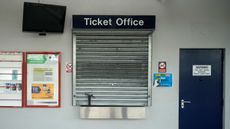
Talking Point Proposal to shut the vast majority of the 1,000-plus ticket offices across England has prompted uproar
By The Week Staff Published 15 July 23

By Brigid Kennedy Published 26 June 23

By Justin Klawans Published 12 March 23

By Justin Klawans Published 16 October 22
- Contact Future's experts
- Terms and Conditions
- Privacy Policy
- Cookie Policy
- Advertise With Us
The Week is part of Future plc, an international media group and leading digital publisher. Visit our corporate site . © Future US, Inc. Full 7th Floor, 130 West 42nd Street, New York, NY 10036.

Get our Rail Planner app
Plan your trip, get extra discounts, and show your Pass as you go.

Our favorite spring routes
Celebrate spring with these 7 off-the-beaten-path train routes

All about seat reservations
Everything you need to know about booking your seats

Alternatives to Busy Routes
Travel between popular European cities without seat reservations

Through our Chatbot in the bottom right corner.

Ask the Community
Browse questions from fellow Eurail travellers, or ask your own!
- Order overview
- Reservations overview
- My Trips & Travelers
- {{translatedTraveler}} {{#promotional}} {{currencySign}} {{standardPrice}} {{/promotional}} {{quantity}}x {{currencySign}} {{finalPrice}}
- Child {{childPasses}}x FREE
- {{translatedPassType}}
- {{translatedValidityPeriodDescription}}
- {{translatedClass}}
- Remove Pass(es)
- {{variant.localizedTravelPackDescription}} {{quantity}}x Free
- {{variant.localizedPassUpgradeDescription}} {{quantity}}x {{currency}} {{price}}
- Your order will arrive by {{expectedDeliveryDate}} 1 x {{currency}} {{price}}
Your cart is empty

Tour Europe with 1 rail Pass
Follow your curiosity around up to 33 countries, traveling at your own pace by train
Tour Europe by train
with 1 Pass
Create the itinerary
for your perfect trip
Travel flexibly on trains
that don’t need reservations
Stay conscious
and travel sustainably
Build your Eurail adventure in 4 easy steps
1 plan your route.
Plan where you’re going and which trains will take you there.
2 Find your Pass
Travel with a Global Pass or a One Country Pass - It’s up to you.
3 Reserve your seats
Do your trains need seat reservations? Book them early!
4 Activate your Pass
Add your Pass to the app, activate it, and jump on a train!
Secure your plans by reserving seats
Most popular rail passes.
Global Pass
7 travel days
- Travel any 7 days within 1 month
- Perfect for visiting 6-8 destinations
- Change your mind? 85% refundable
10 travel days
- Travel any 10 days within 2 months
- Perfect for visiting 9–11 destinations
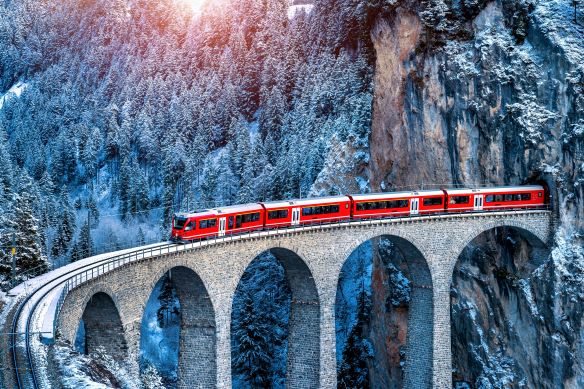
“We were on the road for two months and traveled to 16 cities and 10 countries. Through Eurail you get the chance to create your own individual route.” Tamara and Natalie

“I had the freedom to go at my own pace and find unexpected adventures, enjoying spectacular landscapes and discovering natural beauty. In short, a unique and unforgettable adventure." Lucas

“I loved Eurailing! It was cool to see how trains operate in different countries, and how the European network is interlinked. I can’t wait for more international trains and for international rail travel to become the new norm!” Floris

“I loved exploring Europe with my Eurail Pass! It was the perfect complement to my study abroad program and a valuable resource! I was able to visit so many places, and I can’t wait to come back to visit more!” Taylor

“Traveling by train is more than just going from A to B. Your trip already starts at the station, and the experiences and encounters are priceless.” Bram

Ready to travel?
Download our Rail Planner app
Plan your trip and show your Pass as you go.
Change of currency
You cannot change the currency once you have a Pass in your cart. Remove the Pass, and then change the currency on the website header.

Traveling to Europe? Book one of these new train trips.
Europe is in the midst of a great rail revival. An increased awareness of environmental issues , the many hassles of air travel and the mental effort required to drive long distances are all reasons for people to get back onto trains. European passenger numbers are on the rise again, if not quite at pre-pandemic levels .
In response, operators across the continent are investing in new services, tracks and special offers. And it’s only going to get better: Dozens of projects are in motion from the Baltic states to Portugal, with the European Union aiming to double high-speed rail traffic by 2030 and supporting “10 pilot projects to establish new rail services or improve existing ones” right now .
My family’s summer will involve a train journey from Paris to Barcelona, down the Rhône valley and along the Mediterranean coast, but you don’t have to travel at 200 miles an hour to get the best out of Europe’s rail network.
From slow trains to high-speed bargains, there are plenty of options if you’re traveling in Europe in the next few months.
1. New sleepers from Belgium and Sweden
The sleeper train revival is picking up speed. They seemed to be on the way out in 2016, when the government of France, their last stronghold, decided to cut funding for a number of services. Happily, many of those have since been restored, and other countries around Europe — most notably Austria, under the brand name Nightjet — are investing heavily in night trains.
This summer sees the debut of a service between Brussels and Berlin, two key political centers, run by a new company called European Sleeper . Customers can leave Brussels at 7:22 p.m. (or Amsterdam at 10:34 p.m.) on Monday, Wednesday and Friday, and arrive in Berlin at 6:48 a.m. Return trips depart on Sunday, Tuesday and Thursday. There are three types of tickets, starting at $85: a seat, a bed in a six-berth compartment or a bed in a three-bed compartment.
Other night trains have also recently been introduced, such as Stockholm to Hamburg , which started in the fall, or Paris to Vienna , which began in 2021.
I’ve traveled on night trains from Paris to the south of France on a number of occasions. The experience is not luxurious, but it’s generally cheaper than the cost of a flight and a room — and the beds, while slim, are surprisingly comfortable. Be warned, though: The romance of trundling across Europe in the dead of night can make it hard to sleep.
2. German rail pass for $50 a month
Last summer Germany’s national rail company, Deutsche Bahn, offered monthly passes for the country’s huge network for under $10, a response to cost-of-living problems caused by a sharp rise in costs for electricity, food, heating and mobility. The success of that project has led to the introduction of the Deutschland-Ticket , which will cost around $50 a month and allow unlimited travel on all trains, buses and city subway services, with the exception of the most direct and speedy intercity services.
The possibilities are enticing. Beer lovers, for example, could travel from Düsseldorf to Cologne to Bamberg and onward to Munich, hopping off for distinctive local brews along the way. Those in search of scenery, meanwhile, might prefer the West Rhine Railway, stretching down the Rhine from Cologne in the north to Mainz.
One thing to remember: The Deutschland-Ticket is only available as a rolling, app-based subscription. British train expert Mark Smith, better known online as the Man in Seat 61, recommends canceling by the 10th of the month to avoid being charged for more than a month.
3. The first 100-mph locomotive, in the U.K.
Given locomotives are a British invention, the rail network in the United Kingdom can be a disappointment. Yes, it’ll get you where you need to go, eventually, but services are often late, and there’s only one high-speed line, used by Eurostar and domestic services, from London into the Kentish countryside. The current national debate over ongoing construction of HS2 (High Speed 2) offers a reason: NIMBY -ish attitudes tend to triumph over the greater good.
No wonder Britons are wont to retreat into the past for comfort. This year marks the 100th anniversary of the world’s first fully authenticated 100-mph passenger locomotive, the Flying Scotsman; as a result, a number of special excursions are planned. For those who can afford it, the Centenary Weekender looks like the most appealing trip, from London to York and then Edinburgh, followed by a jaunt up Scotland’s beautiful East Coast.
The Flying Scotsman may be unique, but Europe is full of historical interest. There’s another anniversary, too: The Wuppertal Schwebebahn , a remarkable suspension railway that continues to operate, was completed in 1903 . And then there’s the Beaux-Arts Canfranc Station, opened as the crossing point from Spain to France in 1928, which was revived as a hotel this year .
4. A $7 high-speed train in Spain
Budget services are increasingly common in Europe, but no one is moving so fast as Spain’s Avlo , which runs high-speed, low-cost trains between Madrid and Barcelona, with tickets starting around $7. The network is expanding: From the start of June , there’s a new route from the Spanish capital to Andalusia, taking in Cordoba, Seville and Malaga.
In France, there’s Ouigo , which provides high-speed and standard services from Paris to cities all around the country, including Bordeaux, Marseille and Strasbourg. The advantage of the standard service — which offers tickets starting around $11 — is that prices don’t change, so you can get a last-minute bargain. The U.K., too, has a low-cost service , from London to Edinburgh via Newcastle, although tickets are not always such good value.
5. New subway lines in Turkey and England
Few cities have seen such huge investment and rapid improvement in subway provision as Istanbul. Earlier this year, a line connecting Istanbul Airport to the city opened, while other new lines and extensions are entering service all the time. It’s a remarkable turnaround for a city that had virtually no underground transport until 1989.
It’s not the only capital to be investing in underground trains, though. The experience of visiting Copenhagen has been transformed by the 2019 opening of the City Circle Line . Since last summer, visitors arriving at London Heathrow can reach the city center, and much besides , far quicker courtesy of 2022’s Elizabeth Line.
Paris, meanwhile, is in the foothills of a significant expansion program, Grand Paris Express , which will provide new connections in the city’s long-neglected suburbs. You can expect to see those services start to come online next year, when Paris hosts the Olympics and when Metro Line 14 will be extended to Orly, Paris’s second-largest airport.
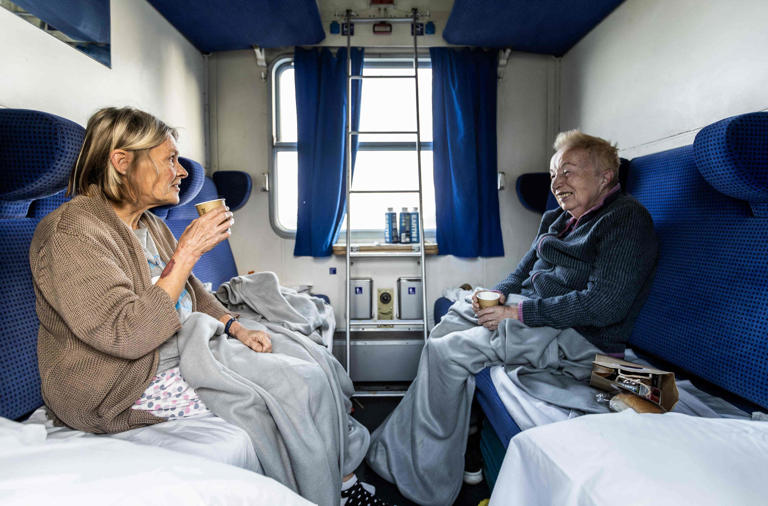

Metro system in MOSCOW – Basic information
The Moscow metro system is one of the busiest and most magnificent in the world. It is estimated that over 8 million people use the metro on a daily basis, and it is comprised of more than 200 stations spread across 12 separate lines . The first station opened in 1935 , and ever since then, the network has been expanding. Each stop has its own distinct personality and is exquisitely designed, with many showcasing art and sculptures. The metro is an excellent and time-saving method of transportation for getting through Moscow and the surrounding areas.
The lines of the Moscow subway system
The Metropolitan Subway, more commonly referred to simply as the Metro, is the primary mode of public transportation in the Russian capital of Moscow. It is one of the busiest and most efficient metro systems in the world, with over 7 million people utilizing it on a daily basis, making it one of the busiest metro systems in the world. It is comprised of 12 lines, each of which has its own distinctive route, and it provides service to the entirety of Moscow as well as the suburbs that surround it.
The Koltsevaya Line and the Radial Line are the two primary lines that make up the Metro. The Koltsevaya Line is a circular line, and the Radial Line extends from the center of Moscow to the outskirts of the city. Because it links all of the major stations in the city, the Koltsevaya Line is by far the most traveled line in the city. It provides service to a total of 15 stations, several of which are among the most well-known in the city. These stations include Komsomolskaya and Belorusskaya.
The Radial Line is the Metro’s longest line , clocking in at more than 30 kilometers in total distance. It provides service to a total of thirty stations, two of which are particularly well-known: Kievskaya and Kurskaya. It is the primary route that commuters take, as it links the central business district to the surrounding suburbs.
Two of the other lines that the Metropolitan Subway serves are the Zamoskvoretskaya Line and the Arbatsko-Pokrovskaya Line . The Zamoskvoretskaya Line travels all the way from the city center to the southwest suburbs of Moscow, and it stops at a total of 14 stations along the way. It is well-known for its architecture, which is a fusion of Art Deco and Socialist Realist styles. This style of architecture has earned it a lot of attention. The Arbatsko-Pokrovskaya Line travels all the way from the city center to the northeastern suburbs of Moscow, and it stops at a total of 12 stations along the way.
The Moscow Metro is widely recognized as one of the most well-designed and effective methods of public transportation in the world. It is an essential part of life in Moscow, as it provides service to the entirety of the city as well as its environs. It is one of the world’s busiest metro systems, with over 7 million people using it on a daily basis , making it one of the busiest in the world.
Map of Moscow Metro 2023 – Free Download in PDF
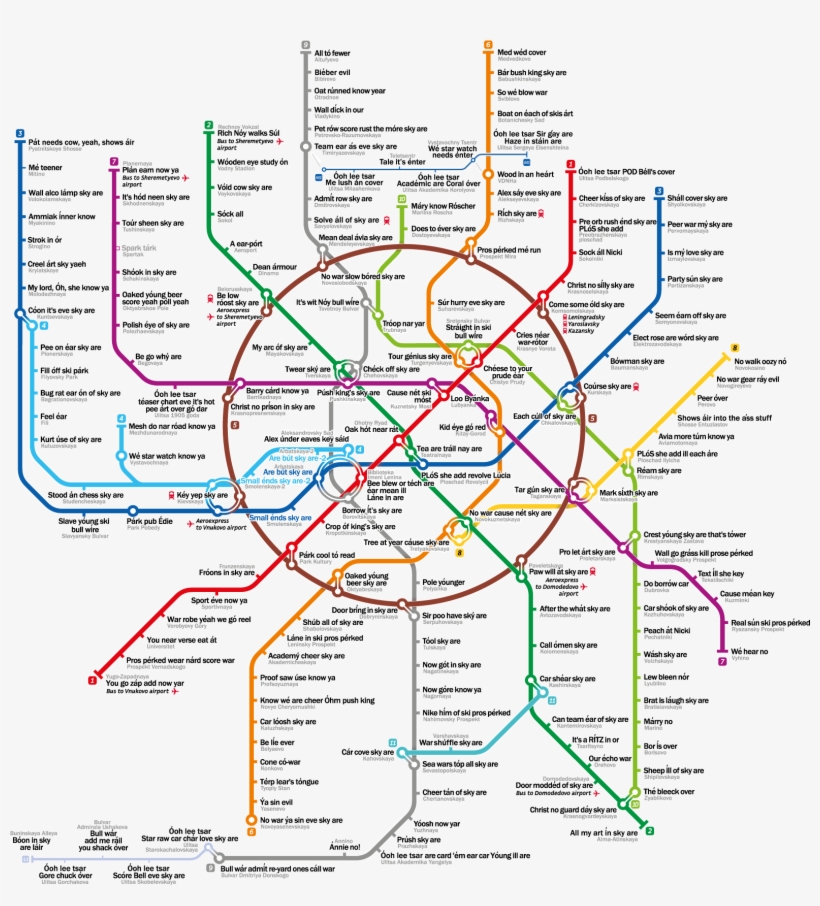
The Map of Moscow Metro 2023 is a free download in PDF format. This map has been designed with the latest in artificial intelligence technology to provide the most accurate and up-to-date information on the Moscow Metro system. With this map, you can easily navigate your way around the city and get to your destination quickly and safely. The map includes all of the stations, lines, and connections in the metro, as well as a detailed description of all the features and services each station provides. Downloading this map is a great way to make the most of your travels in Moscow.
Public transport tickets in Moscow – Best types for travelers & actual prices
In Moscow, the system of public transit is an essential component of daily life. It should come as no surprise that the city’s public transit system is enormous and complicated given that the population of the city is over 12 million. This article will provide information about the many types of tickets that are offered, as well as their costs and where they can be purchased, in order to assist make it easier for readers to navigate the website.
In Moscow, passengers who use the city’s public transit can choose from a number of different ticket options. The Troika card , which is a contactless smart card, is the most prevalent type. The card allows passengers to load money onto it, which may then be used to pay for travel on public transportation systems, including buses, trams, trolleybuses, and the metro.
Classic tickets
One such variety of tickets is known as a Single Ride ticket , and it permits the holder to take a single trip on any sort of public transit. A single-ride ticket can be bought at a number of places, such as metro stations, kiosks, and other sales points. There is also the option to purchase a ticket that is valid for up to ninety minutes of travel on any sort of public transportation and costs ninety dollars. You can also buy this ticket at a lot of kiosks, metro stations, and other places.
Tickets for tourists
In addition to the ordinary tickets, there are also special tickets available for purchase in Moscow that are tailored specifically to the needs of tourists. These tickets include 24-hour, 72-hour, and 7-day passes , all of which may be purchased at metro stations, kiosks, and other shops throughout the city.
The cost of tickets varies widely depending on the kind of ticket that is purchased. For instance, the price of a ticket for a single ride is 45 rubles, while the price of a 24-hour pass is 250 rubles . Pricing could shift marginally from one retail location to another.
You can buy tickets for Moscow’s public transportation at metro stations, kiosks, and other places all over the city. At these retail locations, we’re sorry to say that we can’t accept credit or debit cards as payment. The sole form of payment accepted is cash.
Timetables & Schedules of THE Moscow Metro system
Moscow’s metro is both very popular and very good at getting people where they need to go. This makes it one of the busiest and most advanced public transportation systems in the world. It is open on all seven days of the week and operates from approximately 5:30 am to 1:00 am. The Metro run s on a regular schedule, with service happening anywhere from once every three minutes to once every ten minutes, depending on what time of day it is. The Metropolitan Area Transit Authority, or Metro, makes getting around the city easy and reliable. In addition to this, the price is relatively reasonable, which makes it an appealing alternative for travelers as well as people living in the area.
What Are Other Options For Public Transportation In Moscow?
Public transportation is a big part of life in Moscow, and most commuters take the metro as their main way to get around. There are, however, a great many other transportation choices available to people who would rather not take the subway. Here are some of the other ways to get around Moscow by public transportation: electric trams, buses, trains, and boats.
Buses : Buses are an excellent mode of transportation for moving around Moscow, as there are routes that connect all of the city’s neighborhoods. There are city buses and suburban buses, and the prices for riding each type of bus are varied. The fare for a city bus is normally approximately 40 rubles , whereas the fare for a suburban bus might be as high as 70 rubles .
Trams: Electric trams are a terrific method to go about Moscow, and they are sometimes times faster than buses. There are a lot of trams in Moscow. The city is serviced by a number of different tram lines, and the fare for each ride is approximately 30 rubles .
Minibuses: Minibuses, often known as marshrutkas, are a typical kind of public transportation in Moscow. They operate along predetermined routes, have fares that are comparable to those of buses and trams, but they also make stops at various points along the way. Minibus rides normally cost between 50 and 70 rubles per passenger , depending on the distance traveled.
Trains: Several different train lines may be found operating in and around the city. Because they do not stop as frequently as the metro, these trains offer a fantastic opportunity to go across the city in a hurry. Costs can range anywhere from 40 to 60 rubles (depending on the location), but they are normally in that range.
Taxis : Despite the fact that using a cab is an easy and handy choice, the cost can sometimes be rather high. Depending on where you want to go, the cost of a ride might range anywhere from two hundred to five hundred rubles. It is essential to keep in mind that in order to ensure your safety, taxi rides should only be reserved through a reputable firm that possesses a valid license.
Boats: If you want to see Moscow from the water, renting a boat is a fantastic option. There is a wide variety of options for boat tours and cruises that may be taken, with prices ranging anywhere from 500 to 1000 rubles per person. It is also possible to rent boats hourly, with pricing starting somewhere around 1000 rubles.
These are just some of the different ways to get around Moscow by public transportation. Everyone can choose a mode of transportation that suits their needs, whether they prefer boats, buses, trams, minibuses, trains, or taxis. Because there are so many possibilities, you should have no trouble locating the mode of transportation that best suits your needs.
How To Get From Sheremetyevo International Airport (SVO) To The City Center With Public Transport?
If you are thinking about going to Moscow, there is a good possibility that you will fly into Sheremetyevo International Airport when you get there. The journey from the airport to the heart of the city may present some difficulties, but if you are well-prepared, you should have no trouble reaching your destination. Using public transit is the easiest and most time-efficient way to go from Sheremetyevo Airport to the central business district of Moscow. Public buses, shuttle buses, and even a high-speed train called the Aeroexpress to provide excellent connections to the city from the airport.
The Aeroexpress is the most expedient method of transportation between the airport and the city. Belorussky Rail Terminal is the destination after leaving Terminals D, E, and F of the airport in order to go there. You will have no trouble navigating the city’s subway system from there and arriving at your destination. The Aeroexpress takes about 35 minutes to get to the Belorussky Rail Station. You can buy tickets online or at one of the many kiosks in the airport.
There are a number of buses that may take you to your destination, and you can catch one of them in Terminal E of the airport. The metro station Rechnoy Vokzal can be reached by taking the 851 bus , while the metro station Planernaya can be reached by taking the 817 or the 851 express bus. In addition, bus number 817 makes stops at the Rechnoy Vokzal metro station, and bus number 851 makes stops at the Belorussky Rail Terminal. The travel time for each of these buses is around one hour to reach their final destinations.
Shuttle buses are another alternative that can get you to your destination quickly and affordably, and they leave from each of the airport’s three terminals. Shuttles operate around the city, making stops at a variety of locations, including the Rechnoy Vokzal and Planernaya metro stations. You can purchase tickets for the shuttles either at one of the ticket booths located throughout the airport or directly from the driver. It may take more or shorter than an hour and a half to reach the city center using the shuttles, depending on the amount of traffic that is present along the route.
If you know how to use the different ways to get around, it is not only easy to get from Sheremetyevo Airport to the central business district of Moscow, but it is also very convenient. The Aeroexpress is the most time-efficient choice while taking the buses or shuttles is the most cost-effective way to reach the city from the airport. No matter which course of action you decide to take, getting to where you need to go won’t be a problem for you.
The most convenient way is Bolt! Bolt (European UBER) is a convenient way to get from Ruzyne Airport to the city center. The journey takes around 25 minutes depending on traffic, and the cost is approximately 2.000 Kč. It’s recommended to book a taxi in advance to avoid the queues, or you can pick one up at the taxi stand at the airport.
- Free coupon for a first Bolt ride – 20 EUR
What kind of sightseeing do you have to see if you visit Moscow for the first time?
Moscow, the capital of Russia, is a city filled with amazing attractions that are sure to captivate even the most seasoned traveler. From its iconic Red Square, to its world-famous Kremlin, Moscow is an incredibly popular destination for tourists from all over the world. Here are some of the top attractions to visit when you’re in the city.
- The Red Square is perhaps the most iconic image of Moscow, and this vast city square has become an essential part of the city’s history, culture, and identity. It is the site of many events, such as military parades, concerts, and other official ceremonies. The Red Square is also home to some of the city’s most famous landmarks, including the Kremlin, the State Historical Museum, and the famous GUM shopping center.
- No visit to Moscow is complete without a visit to the Kremlin , the fortified complex that houses the official residence of the President of Russia. The Grand Kremlin Palace, located inside the Kremlin, is a magnificent baroque-style building that was once used as the official residence of Tsars. Visitors to the Kremlin can also explore the Cathedral of the Assumption, the Annunciation Cathedral, and Ivan the Great Bell Tower.
- The State Historical Museum is another must-see attraction in Moscow. Located in Red Square, this museum is one of the oldest in the world, and it houses a vast collection of artifacts, artwork, and other items that document Russian history and culture. The museum has many famous artifacts, including the Siberian Mammoth and the world’s oldest book.
- The iconic GUM shopping center is another popular attraction in Moscow . This grand building is located in Red Square and is one of the city’s most popular shopping destinations. GUM is home to more than 200 stores, many offering luxury fashion items, designer goods, and other products.
Moscow is home to many other attractions, including the Saint Basil’s Cathedra l, the Bolshoi Theatre , the Pushkin Museum of Fine Arts, and the Moscow Metro . Visitors can also explore the many parks and gardens throughout the city, such as Gorky Park and Alexander Garden. Whether you’re looking for a cultural experience or some relaxation, Moscow has something for everyone.
Summary of our tour guide for Moscow
The city of Moscow has a population of about 12 million people, making it a lively and active metropolis. Moscow is the most populated city in Europe and the capital of Russia; as such, it is also a center of culture, artistic production, and commercial activity. The Moscow Metro is by far the most common and widely used mode of public transportation, despite the city’s enormous and well-functioning public transportation network. The Moscow Metro is a must-see sight both because of its distinctive and ornate architecture and because it provides an expedient method to move between the many sites that are located in Moscow. The city has a diverse selection of public transportation choices, such as buses, trams, trolleybuses, and even riverboats, so residents may easily navigate the area.
Top 5 FAQs and answers about Moscow public transport?
Getting around Moscow can be a bit confusing, especially if you are unfamiliar with the city’s public transport system. With so many options to choose from, it can be difficult to know which one is the best for you. Here are the answers to five frequently asked questions about Moscow public transport. 1. What types of transportation are available in Moscow?
- The Moscow public transport system includes buses, trams, trolleybuses, metro, suburban railways, and taxis. The Moscow Metro is the most popular and convenient way of getting around the city, with over 200 stations and 13 lines covering most of the city. Buses and trams are also popular, and they have the advantage of being able to go to places that are not covered by the Metro. Suburban railways and trolleybuses are also available, though they may be less convenient. Taxis are also a good option, though they can be quite expensive.
2. How much does it cost to use public transport in Moscow?
- The cost of using public transport in Moscow varies depending on the type of transport you are using. Single tickets for the Metro cost 55 rubles, and for buses and trams, it is 28 rubles. If you plan on using public transport multiple times, you can buy a card with a set amount of money loaded onto it. This card can be used for multiple rides on the Metro, buses, trams, and trolleybuses.
3. How do I pay for public transport in Moscow?
- You can pay for public transport in Moscow with cash or a bank card. If you are using the Metro, you can also purchase a Troika card, which is a reusable card that can be loaded with money. This card can be used on the Metro as well as on buses, trams, and trolleybuses.
4. Is there a way to get around Moscow without using public transport?
- Yes, there are several ways to get around Moscow without using public transport. Most people choose to walk because most of the city is flat and easy to get around on foot. You can also rent a bike or scooter if you want to get around faster. There are also a few companies that offer car-sharing services, which can be a convenient and affordable way to get around.
5. Is there a website or app I can use to plan my trips?
- Yes, there are several websites and apps that you can use to plan your trips in Moscow. Yandex.Taxi is a popular app that allows you to book a taxi or car-sharing service, and Yandex.Metro is a website and app that can help you plan trips using the Metro. You can also use Google Maps to plan trips using public transport, as well as to find the best routes to take.
Useful links
- Official website of public Moscow transport company
Leave a Comment Cancel reply
Save my name, email, and website in this browser for the next time I comment.
most recent

Asia , Japan
Hiroshima rapid transit line (astram line) – tourist guide.

Asia , China
Ürümqi metro: practical tips for tourists.

Nagoya Municipal Subway

Yokohama Municipal Subway – Tour guide

Kyoto Municipal Subway

Sapporo Municipal Subway
PH +420 607 777 83
Na Folimance 2155/15 Prague, 120 00
© info 2024
Introducing Moscow Sheremetyevo International Airport
- About Moscow Sheremetyevo International Airport
Book your flight
.png)
About Moscow Sheremetyevo International Airport (SVO)
One of three major airports in Moscow, Moscow Sheremetyevo International Airport is located to the northwest of the Russian capital. Our Moscow Sheremetyevo International Airport guide includes information on terminal facilities, public transport routes and nearby hotels, as well as contact details for the airport.
Information:
Information desks and touch screen terminals are located in the main halls; these provide up-to-date flight information (tel: +7 495 578 6565) and details about the airport and transport to the city.
Driving directions:
The main road leading to Moscow Sheremetyevo International Airport is Leningradskoe Highway, which flows into the M10 motorway from Moscow.
Transfer between terminals:
Public buses, express buses and free airline shuttles are available for transfer between Sheremetyevo's terminals, which are split between two separate sites. Terminal A is used solely for business and private flights.
Airport Info
Moscow Sheremetyevo International Airport is located 29km (18 miles) northwest of Moscow.
+7 495 578 6565.
Public Transport
Public transport road:.
Bus: Regular express buses run 24 hours a day to central Moscow from bus stops outside Terminal B and the bus station on the arrivals level of Terminal F. Bus 851 links to Rechnoi Vokzal metro station, while bus 817 runs to Planernaya metro station. Fares vary between services.
Coach: Coach services operate between Moscow Sheremetyevo International Airport and Moscow Central Air Terminal, which is located between the Dinamo and Aeroport metro stations.
Taxi: Taxis to Moscow are available 24 hours a day from the arrivals level of Terminal F and from outside Terminal D and E; passengers should join the taxi queue for fixed-rate taxis, rather than accepting offers from drivers.
Public transport rail:
Rail: Aeroexpress (tel: +7 800 700 3377; https://aeroexpress.ru/ ) trains connect directly from Moscow Sheremetyevo International Airport to Belorussky Railway Station in central Moscow (journey time: 35 minutes). Free bus links connect the rest of the airport complex to the Aeroexpress station.
Terminal facilities
Moscow Sheremetyevo International Airport offers banking and bureaux de change facilities. Currency exchange services are available in departures in Terminal D,E and Terminal F, while ATMs are located in Terminals D,F and the arrival area of Terminal E.
There is a wide choice of restaurants, cafés and bars in each passenger terminal. These encompass a range of international and locally branded establishments, from a Teremok cafe in Terminal D to a sushi bar in Terminal F.
A good selection of shops is available in each of the main terminals. These include duty-free outlets, gift shops, pharmacies and newsagents.
Luggage trolleys can be hired in the arrivals hall of Terminal F, and luggage packing facilities are also available. A porter service is available to assist passengers on request. Luggage rooms can be found in Terminals D, E and F. A lost property office (tel: +7 495 578 4782) can be found in Terminal C. A lost property office (tel: +7 495 578 7464) is also on hand to assist passengers who have misplaced (or recovered) items in the airport complex.
Moscow Sheremetyevo International Airport has a medical office, shower rooms and baby care facilities. There are travel agencies in Terminal F to assist with tour information and bookings.
Airport facilities
Conference and business:.
The VIP and business lounges in Terminals D, E and F offer a selection of facilities, such as showers, refreshments and communication services. Additionally, the on-site Novotel Moscow Sheremetyevo Airport (tel: +7 495 626 5900; www.accorhotels.com ) has nine meeting rooms and offers fax and copying services. Terminal A is used exclusively for business travellers and includes a large conference room.
Communication Facilities:
Free Wi-Fi internet access is available in all terminals. Additionally, there are postal, fax, photocopying and international dialling services in Terminals F.
Disabled facilities:
Wheelchair transfer and special assistance is available between the aircraft and the terminal building on request – passengers requiring such services should make a request by submitting an application online and inform their airline prior to travel. The Sirius Lounge, in the departures area of Terminal E, is accessible to departing passengers from Terminals D, E and F, while The Saturn Lounge is located in the public area of Terminal D. Both lounges are equipped with individual service rooms, internet facilities for the visually impaired, and disabled toilets. There are designated parking spaces, which can be booked in advance, free of charge (+7 495 988 0448). The Aeroexpress train is accessible to the physically disabled, with assistants on hand to help where required.
Car parking:
Short-term parking facilities are available close to the terminals.
Car rental:
Car hire companies Sixt, TIScar, AVIS and IDrive have offices in Terminal D.

© Columbus Travel Media Ltd. All rights reserved 2024

IMAGES
COMMENTS
It's an interactive map, so start clicking around and planning your trip! Click on the train icons to see the cities of each country, and click on the routes (the lines in between 2 train icons) to see travel times. The green lines represent trains; the blue lines are ferries. Please note that routes may change throughout the year.
Travel times for popular routes. See how long it takes to travel by train between some of Europe's most popular cities. Please note that the seat reservation prices on this page are indicative only and subject to change. Prices may differ when booking reservations through an agent or paying in the local currency.
Our interactive train map of Europe highlights some of the most popular rail routes across Spain, France, Switzerland, Germany and Italy. Click on each of the routes in our map below to find journey times and where to book your tickets. *Routes are subject to change throughout the year. If a route you had in mind isn't featured on our map ...
A Travellers Railway map of Europe is an' excellent detailed map of European rail routes, ideal for travelling around Europe by train. It covers the whole of Europe from Portugal in the west to Moscow & Istanbul in the east, Finland in the north to Sicily and Athens in the south. On the back are detailed maps of Switzerland, Benelux and Germany ...
European Rail Maps. Rail Travel Maps. Albania Austria Belarus Belgium Bosnia Bulgaria Croatia Czech Republic Denmark England Estonia Finland France Germany Greece Hungary Ibiza Ireland Italy Kosovo Latvia Lithuania Luxembourg Macedonia Mallorca Moldova Montenegro Netherlands Norway Poland Portugal Romania Scotland Serbia Slovakia Slovenia Spain Sweden Switzerland Turkey Ukraine United Kingdom ...
From this map we have created a page about each country of mainland Europe complete with a railway map of each country as well as rail travel notes and useful web links. Click on the relevant area on the map below to jump to that page. In addition to the country pages we also have two large maps that you can zoom in to and scroll across, one of ...
Use our route planner to map out your journey around Europe and book the best accommodation. Eurail Planner is a planning tool for European rail trips. Map out your route and search for accommodation with ease. Toggle navigation. Premium; Passes; Blog; ... Travel in 33 countries with a set number of travel days in a 1-2 month period.
This guide to European train travel includes links to maps, timetables, and rail passes for Europe's high-speed intercity passenger trains, local railways, subways, metros, trams, and transit. Trains & Travel International - Experts in rail travel since 1985, offering rail tours and railfan charters. Abbey Flyer Users Group - Aims to secure the ...
European Railway Map. You can zoom in to this detailed map of the railways of Europe by using the +/- buttons or by using the wheel on your mouse whilst hovering over the map. -. This map of the railways of Europe has been kindly supplied to us by European Rail Timetable Limited ( www.europeanrailtimetable.eu ).
The Rail Map Europe comes with an impeccable pedigree, for it is regularly updated by the expert team who compile the monthly European Rail Timetable. A good compromise: the ERA. Travellers looking for more detail than one might find on the Rail Map Europe might sensibly turn to the wonderful range of atlases published by Mike Ball. These are ...
UIC has received the new Travellers' Railway Map of Europe from Dutch editor Carto Studio BV. The map is designed for travellers who wish to discover Europe by train. In order to facilitate the use of this map, the railway network is classified into several categories: high speed lines, main lines, and secondary and tourist lines.
Description: This map shows high speed lines, mail lines, secondary lines and railway stations in Europe.
A Travellers' Railway Map of Europe. By Railway Gazette International 4 June 2011. Book review. EUROPE: Dutch cycling map publisher Carto Studio has published a map of the European railway network which is says aimed at 'people who like to travel by train and who would like to follow their own journey throughout Europe.'. The rail network is ...
How To Derive The Greatest Benefit From The Europe Train Map. You can find a Europe train map on any website that offers a comprehensive range of travel options throughout the continent, not to mention any of the railway stations which are part of the international network. It is now easier than ever before to plan your journey throughout the European continent, and to buy your travel in ...
A Travellers` Railway Map of Europe from Carto Studio presenting the Continent in a series of six maps and their enlargements, including 12 city maps indicating locations of their main railway stations and a map of the high-speed network.On one side it an overview map of Europe at 1:3,800,000, with coverage extending north to Oslo.
Visualize where you can travel by train in Europe on this interactive map. Visualize where you can travel by train in Europe on this interactive map. Chronotrains About. Maximum travel time. 1 h2 h3 h4 h5 h6 h7 h8 h. Where can you go by train in 8h? This map shows you how far you can travel from each station in Europe in less than 8 hours.
This Eurail & Interrail map has all the big city train connections in Europe. Play around with the map and figure out the routes you intend to take and learn about the average travel time. Make a rough cost estimation of point-to-point tickets and compare it to the Eurail or Interrail Pass price, to identify if the pass is ideal for you ...
Using the train in Spain can be quicker and cheaper than flying. For example, a flight from Madrid to Barcelona takes 1¼ hours compared with 2½ hours by high-speed rail. But once you factor in security checks, out-of-city airport transfers, and runway taxi times, the overall journey length by plane becomes longer.
The first step to traveling through Europe by train like a pro is to plan ahead. Research your destinations and create a rough itinerary of the places you want to visit, as well as the duration of ...
Zurich to Zagreb. Crossing five countries in around 15 hours, this is "one of Europe's most scenic routes", said Lonely Planet. It is particularly "worth taking" in summer, as it passes through ...
Follow your curiosity around up to 33 countries, traveling at your own pace by train. Find your pass. Tour Europe by train. with 1 Pass. Create the itinerary. for your perfect trip. Travel flexibly on trains. that don't need reservations. Stay conscious.
New European Sleeper train connects four capitals from Brussels to Prague. Customers can leave Brussels at 7:22 p.m. (or Amsterdam at 10:34 p.m.) on Monday, Wednesday and Friday, and arrive in ...
Except Vostochny Rail Terminal, all rail terminals are located close to the city center, but each handles trains from different parts of Europe and Asia. There are smaller railway stations in Moscow. As train tickets are relatively cheap, they are the mode of preference for travelling Russians, especially when departing to Saint Petersburg ...
The Paris to Alassio train travel takes about 7 hours and 44 minutes, no matter when you leave. What are the Paris to Alassio train times and schedule? If you're travelling on a weekday, you'll find the earliest train to Alassio leaving Paris at around 06:07 and the last train leaving at around 21:37 .
When you have an Interrail, Eurail, or Swiss Travel pass, you sometimes have to buy an additional seat reservation to travel on your preferred train. This seat reservation is also called a pass supplement or a passholder fare. Passholder fares are shown in search results on Rail Europe when you have selected one of the three rail passes ...
The map includes all of the stations, lines, and connections in the metro, as well as a detailed description of all the features and services each station provides. Downloading this map is a great way to make the most of your travels in Moscow. Public transport tickets in Moscow - Best types for travelers & actual prices
Public transport rail: Rail: Aeroexpress (tel: +7 800 700 3377; https://aeroexpress.ru/) trains connect directly from Moscow Sheremetyevo International Airport to Belorussky Railway Station in central Moscow (journey time: 35 minutes). Free bus links connect the rest of the airport complex to the Aeroexpress station.
A woman views a map showing the eclipse path during the Solar Eclipse Festival at the California Science Center in Los Angeles, California, on August 19, 2017, two days before the total eclipse on ...
Moscow Rail Map - Available now as a poster! Moscow Rail Map - Poster 40x60 cm; Moscow Rail Map - Poster 60x90 cm; The poster of the Moscow Rail Map is available in the Urban-Map online print shop worldwide. Printing, delivery and service by Spreadshirt. Production and sales are in Europe, America and Australia and available to ship worldwide ...